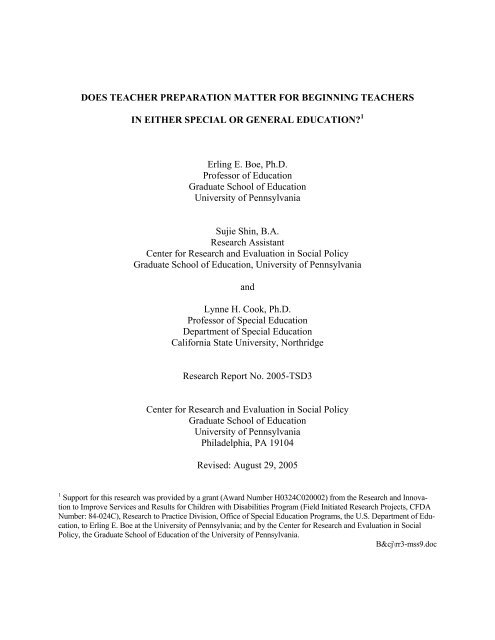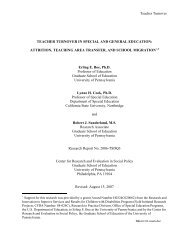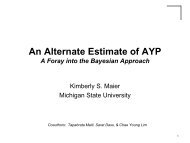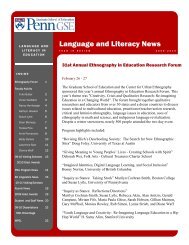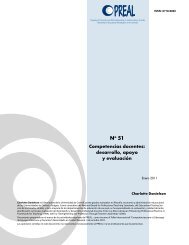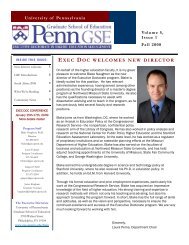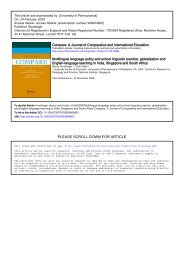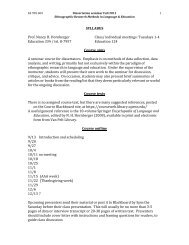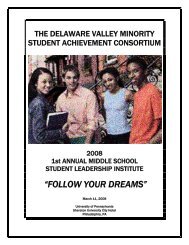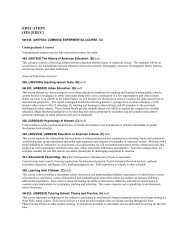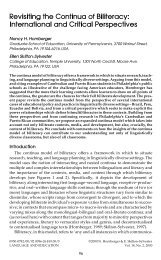does teacher preparation matter for beginning teachers in
does teacher preparation matter for beginning teachers in
does teacher preparation matter for beginning teachers in
You also want an ePaper? Increase the reach of your titles
YUMPU automatically turns print PDFs into web optimized ePapers that Google loves.
DOES TEACHER PREPARATION MATTER FOR BEGINNING TEACHERS<br />
IN EITHER SPECIAL OR GENERAL EDUCATION? 1<br />
Erl<strong>in</strong>g E. Boe, Ph.D.<br />
Professor of Education<br />
Graduate School of Education<br />
University of Pennsylvania<br />
Sujie Sh<strong>in</strong>, B.A.<br />
Research Assistant<br />
Center <strong>for</strong> Research and Evaluation <strong>in</strong> Social Policy<br />
Graduate School of Education, University of Pennsylvania<br />
and<br />
Lynne H. Cook, Ph.D.<br />
Professor of Special Education<br />
Department of Special Education<br />
Cali<strong>for</strong>nia State University, Northridge<br />
Research Report No. 2005-TSD3<br />
Center <strong>for</strong> Research and Evaluation <strong>in</strong> Social Policy<br />
Graduate School of Education<br />
University of Pennsylvania<br />
Philadelphia, PA 19104<br />
Revised: August 29, 2005<br />
1 Support <strong>for</strong> this research was provided by a grant (Award Number H0324C020002) from the Research and Innovation<br />
to Improve Services and Results <strong>for</strong> Children with Disabilities Program (Field Initiated Research Projects, CFDA<br />
Number: 84-024C), Research to Practice Division, Office of Special Education Programs, the U.S. Department of Education,<br />
to Erl<strong>in</strong>g E. Boe at the University of Pennsylvania; and by the Center <strong>for</strong> Research and Evaluation <strong>in</strong> Social<br />
Policy, the Graduate School of Education of the University of Pennsylvania.<br />
B&cj\rr3-mss9.doc
ABSTRACT<br />
The current USDOE emphasis on the <strong>preparation</strong> of <strong>teacher</strong>s <strong>in</strong> content knowledge, as opposed<br />
to pedagogy or teach<strong>in</strong>g practicums, represents a major policy issue concern<strong>in</strong>g how best<br />
to produce and certify a sufficient supply of qualified <strong>teacher</strong>s. Accord<strong>in</strong>gly, the purpose of this<br />
research was to <strong>in</strong>vestigate a wide range of outcomes <strong>for</strong> <strong>beg<strong>in</strong>n<strong>in</strong>g</strong> <strong>teacher</strong>s <strong>in</strong> relation to<br />
amount of <strong>teacher</strong> <strong>preparation</strong>—extensive, some, and no <strong>preparation</strong>.<br />
Specifically, we used recent national data from the Schools and Staff<strong>in</strong>g Survey to per<strong>for</strong>m<br />
several analyses of special education <strong>teacher</strong>s (SETs) and general education <strong>teacher</strong>s (GETs) <strong>in</strong><br />
their first five years of employment <strong>in</strong> public schools. One analysis quantified the numbers of<br />
these <strong>beg<strong>in</strong>n<strong>in</strong>g</strong> <strong>teacher</strong>s with each of the three amounts of <strong>teacher</strong> <strong>preparation</strong>, and three analyses<br />
<strong>in</strong>vestigated the effects of <strong>teacher</strong> <strong>preparation</strong> on <strong>teacher</strong> qualification variables, job placement<br />
variables, and dimensions of how well <strong>beg<strong>in</strong>n<strong>in</strong>g</strong> <strong>teacher</strong>s were prepared <strong>for</strong> their assignments.<br />
Results <strong>in</strong>dicated that a substantial majority (83%) of <strong>beg<strong>in</strong>n<strong>in</strong>g</strong> SETs nationally completed<br />
extensive <strong>teacher</strong> <strong>preparation</strong> while 12% completed only some <strong>preparation</strong> and another 6% did<br />
not complete any <strong>preparation</strong>. These percentages were similar <strong>for</strong> GETs. Complet<strong>in</strong>g extensive<br />
<strong>teacher</strong> <strong>preparation</strong> <strong>matter</strong>s a great deal to both SETs and GETs <strong>in</strong> atta<strong>in</strong><strong>in</strong>g two key <strong>teacher</strong><br />
qualifications (full certification and <strong>in</strong>-field teach<strong>in</strong>g assignments), while those complet<strong>in</strong>g only<br />
some <strong>preparation</strong> were seriously disadvantaged <strong>in</strong> both respects. Similarly, complet<strong>in</strong>g extensive<br />
<strong>teacher</strong> <strong>preparation</strong> <strong>matter</strong>s considerably <strong>in</strong> the hir<strong>in</strong>g of <strong>beg<strong>in</strong>n<strong>in</strong>g</strong> SETs and GETs <strong>in</strong>to schools<br />
<strong>in</strong> which <strong>teacher</strong>s prefer to practice. Beg<strong>in</strong>n<strong>in</strong>g <strong>teacher</strong>s who completed only some <strong>preparation</strong> or<br />
have no <strong>preparation</strong> were disadvantaged <strong>in</strong> this respect.<br />
Four <strong>teacher</strong> qualification variables (amount of <strong>teacher</strong> certification, <strong>in</strong>- vs. out-of-field degree<br />
major, full vs. part certification, and degree major <strong>in</strong> education vs. major <strong>in</strong> other field) were<br />
used <strong>in</strong> multivariate analyses to predict <strong>teacher</strong> reports of be<strong>in</strong>g well prepared to teach <strong>in</strong> terms<br />
of subject <strong>matter</strong> and four pedagogical skills. With respect to be<strong>in</strong>g well prepared to teach subject<br />
<strong>matter</strong>, extensive <strong>teacher</strong> <strong>preparation</strong> <strong>matter</strong>ed most <strong>for</strong> <strong>beg<strong>in</strong>n<strong>in</strong>g</strong> SETs while hav<strong>in</strong>g an <strong>in</strong>field<br />
teach<strong>in</strong>g assignment <strong>matter</strong>ed most <strong>for</strong> GETs. With respect to be<strong>in</strong>g well prepared <strong>in</strong> four<br />
pedagogical skills, complet<strong>in</strong>g extensive <strong>teacher</strong> <strong>preparation</strong> <strong>matter</strong>ed a great deal <strong>for</strong> both SETs<br />
and GETs, while complet<strong>in</strong>g only some <strong>teacher</strong> <strong>preparation</strong> <strong>matter</strong>ed little.<br />
Thus, when it comes to the two central components of the def<strong>in</strong>ition of a highly qualified<br />
<strong>teacher</strong> (full certification and subject <strong>matter</strong> expertise) <strong>in</strong> the No Child Left Beh<strong>in</strong>d Act, complet<strong>in</strong>g<br />
extensive <strong>teacher</strong> <strong>preparation</strong> <strong>matter</strong>s a great deal <strong>in</strong> prepar<strong>in</strong>g qualified <strong>beg<strong>in</strong>n<strong>in</strong>g</strong> SETs and<br />
GETs. Programs offer<strong>in</strong>g extensive <strong>teacher</strong> <strong>preparation</strong> (predom<strong>in</strong>antly traditional universitybased<br />
degree programs) also produce qualified <strong>teacher</strong>s <strong>in</strong> much greater numbers than programs<br />
offer<strong>in</strong>g lesser amounts of <strong>preparation</strong>—a major benefit to the field <strong>in</strong> light of dire shortages of<br />
qualified SETs and <strong>in</strong> selected fields of general education. In view of the effectiveness programs<br />
offer<strong>in</strong>g extensive <strong>teacher</strong> <strong>preparation</strong> (ma<strong>in</strong>ly traditional programs) <strong>in</strong> produc<strong>in</strong>g large numbers<br />
of graduates to address <strong>teacher</strong> shortages, it is counterproductive of Federal policy to focus on<br />
the promotion of alternative route programs at the expense of traditional programs.<br />
ii
CONTENTS<br />
Page<br />
Introduction ....................................................................................................................................... 1<br />
Method .............................................................................................................................................. 4<br />
Data Source ................................................................................................................................... 4<br />
Teachers Studied............................................................................................................................ 4<br />
Teacher Def<strong>in</strong>ition ...................................................................................................................... 4<br />
Def<strong>in</strong>itions of Special and General Education Teachers............................................................ 4<br />
Teacher Sample........................................................................................................................... 5<br />
Design ........................................................................................................................................... 5<br />
Amount of Teacher Preparation ................................................................................................. 5<br />
1. Extensive Teacher Preparation............................................................................................ 6<br />
2. Some Teacher Preparation................................................................................................... 6<br />
3. Little or No Teacher Preparation......................................................................................... 6<br />
Teacher qualification variables .................................................................................................. 6<br />
1. Certification <strong>in</strong> Ma<strong>in</strong> Teach<strong>in</strong>g Assignment ....................................................................... 7<br />
2. In- and Out-of-Field Teach<strong>in</strong>g Assignment ........................................................................ 7<br />
3. Degree Major Field ............................................................................................................. 7<br />
4. Degree Level ....................................................................................................................... 7<br />
Teacher Position variables.......................................................................................................... 8<br />
1. Time of Entry <strong>in</strong>to Teach<strong>in</strong>g Employment.......................................................................... 8<br />
2. School M<strong>in</strong>ority Enrollment................................................................................................ 8<br />
3. Teachers’ Union Membership............................................................................................. 8<br />
4. Regular vs. Charter Public School ...................................................................................... 8<br />
5. Full- vs. Part-Time Employment......................................................................................... 8<br />
Teacher Reports of Be<strong>in</strong>g Well Prepared to Teach.................................................................... 8<br />
Analysis Procedures ...................................................................................................................... 9<br />
iii
Results and Discussion ...................................................................................................................... 9<br />
Do Teacher Qualifications Vary by Amount of Teacher Preparation?.......................................... 11<br />
Certification <strong>in</strong> Ma<strong>in</strong> Teach<strong>in</strong>g Assignment .............................................................................. 11<br />
In- and out-of-field teach<strong>in</strong>g assignment.................................................................................... 11<br />
Degree major field...................................................................................................................... 11<br />
Degree Level .............................................................................................................................. 13<br />
Do Teach<strong>in</strong>g Positions Vary by Amount of Teacher Preparation? ............................................... 13<br />
Time of Entry Into Teach<strong>in</strong>g Employment ................................................................................ 13<br />
School M<strong>in</strong>ority Enrollment....................................................................................................... 13<br />
Teachers’ Union Membership.................................................................................................... 15<br />
Regular vs. Charter Public Schools............................................................................................ 15<br />
Full- vs. Part-Time Employment................................................................................................ 15<br />
Do Teacher Reports of Be<strong>in</strong>g Well Prepared to Teach Vary by Amount of Preparation? ........... 15<br />
Conclusion ........................................................................................................................................ 23<br />
References ......................................................................................................................................... 27<br />
Appendix A ....................................................................................................................................... 30<br />
Appendix B ....................................................................................................................................... 31<br />
iv
INTRODUCTION<br />
There are two routes to state certification of elementary and secondary <strong>teacher</strong>s <strong>in</strong> the<br />
United States—traditional and alternative. Traditional <strong>teacher</strong> <strong>preparation</strong> is offered by colleges<br />
and universities. Though there is considerable variability among traditional programs across and<br />
with<strong>in</strong> states, they all provide <strong>in</strong>struction <strong>in</strong> pedagogy and unpaid experience <strong>in</strong> supervised practice<br />
teach<strong>in</strong>g from 8 to 16 weeks [National Association of State Directors of Teacher Education<br />
and Certification (NASDTEC), 2003]. These programs lead to a bachelor’s or master’s degree<br />
with a major <strong>in</strong> <strong>teacher</strong> education or <strong>in</strong> an academic discipl<strong>in</strong>e. They are the predom<strong>in</strong>ant source<br />
of prepared <strong>teacher</strong>s, with the number of graduates estimated to be <strong>in</strong> excess of 200,000 annually<br />
(Boe, Cook, Sunderland, McGrew, & May, 2005).<br />
In addition, states have established a wide variety of alternative routes to certification (ARC)<br />
dur<strong>in</strong>g the past two decades (Feistritzer, 2005). The most common types of ARC programs make<br />
it possible <strong>for</strong> aspir<strong>in</strong>g <strong>teacher</strong>s, who have already earned a bachelor’s or higher degree, to circumvent<br />
traditional university-based <strong>teacher</strong> <strong>preparation</strong>. Though there is great variability among<br />
alternative programs, they typically provide some <strong>in</strong>struction <strong>in</strong> pedagogy and place participants<br />
<strong>in</strong> full-time paid supervised employment as <strong>teacher</strong>s soon after program admission. In an ef<strong>for</strong>t<br />
to <strong>in</strong>crease the supply of <strong>teacher</strong>s <strong>in</strong> light of chronic shortages, ARC programs had proliferated to<br />
such an extent by 2004, that 46 states offered 115 ARC programs of 10 different types that produced<br />
an estimated 35,000 completers annually (Feistritzer).<br />
In spite of their differences, traditional and alternative <strong>teacher</strong> <strong>preparation</strong> both provide <strong>in</strong>struction<br />
<strong>in</strong> pedagogy and supervised classroom teach<strong>in</strong>g experience. What varies <strong>for</strong> both types<br />
is the amount and components <strong>in</strong>cluded <strong>in</strong> <strong>preparation</strong> as represented by “methods courses, field<br />
experiences, supervision, and mentorship” (S<strong>in</strong>delar, Daunic, & Rennelss, 2004, p. 210). Traditional<br />
programs typically provide extensive <strong>in</strong>struction <strong>in</strong> pedagogy and practice teach<strong>in</strong>g<br />
(NASDTEC, 2003), while ARC programs are much more variable <strong>in</strong> the amount of <strong>in</strong>struction<br />
provided <strong>in</strong> pedagogy even though provid<strong>in</strong>g full-time paid employment as <strong>teacher</strong>s (Feistritzer,<br />
2005; Rosenberg & S<strong>in</strong>delar, <strong>in</strong> press). Accord<strong>in</strong>g to the reviews of research by S<strong>in</strong>delar et al.<br />
and Brownell, Hirsch, & Seo (2004), more <strong>in</strong>tensive ARC programs <strong>in</strong> these respects tend to<br />
produce more effective <strong>teacher</strong>s.<br />
Dur<strong>in</strong>g recent years, the effectiveness of <strong>teacher</strong> <strong>preparation</strong> lead<strong>in</strong>g to certification has been<br />
challenged by many observers (e.g., F<strong>in</strong>n, 1999; Walsh, 2001) as represented by the perspective<br />
1
of the <strong>for</strong>mer Secretary of Education, Rod Paige, <strong>in</strong> his first Annual Report on Teacher Quality<br />
[U.S. Department of Education (USDOE), 2002]. On the basis of his review of available “scientifically<br />
rigorous” evidence (from Goldhaber & Brewer, 1999; and Walsh, 2001), the Secretary<br />
stated that neither attendance at traditional schools of education nor <strong>teacher</strong> certification improved<br />
student achievement. Likewise with respect to ARC programs, the Secretary stated that<br />
“further research is required to provide evidence of their effectiveness” (p. 21). With respect to<br />
the production of qualified <strong>teacher</strong>s, he concluded that the “best available research shows that<br />
solid verbal ability and content knowledge are what <strong>matter</strong>s most” (p. 9).<br />
With the passage of the No Child Left Beh<strong>in</strong>d Act (NCLB) of 2001, the topic of <strong>teacher</strong><br />
quality has been spotlighted. The <strong>for</strong>mer Secretary of Education’s perspective on what <strong>matter</strong>s<br />
most is represented <strong>in</strong> NCLB’s def<strong>in</strong>ition of a “highly qualified <strong>teacher</strong>” (HQT). It focuses “on<br />
<strong>preparation</strong> <strong>in</strong> content knowledge, as opposed to components such as pedagogy or teach<strong>in</strong>g practicums”<br />
(USDOE, 2002, p. 6). Accord<strong>in</strong>gly, the emphases on improv<strong>in</strong>g <strong>teacher</strong> qualifications <strong>in</strong><br />
NCLB have been on promot<strong>in</strong>g academic <strong>preparation</strong> <strong>in</strong> each subject <strong>matter</strong> taught and professional<br />
development <strong>for</strong> practic<strong>in</strong>g <strong>teacher</strong>s that emphasizes subject <strong>matter</strong> (see also USDOE,<br />
2003; USDOE, 2004; White House, 2002).<br />
Thus, the current USDOE position on <strong>teacher</strong> <strong>preparation</strong> emphasizes subject <strong>matter</strong> and deemphasizes<br />
tra<strong>in</strong><strong>in</strong>g <strong>in</strong> pedagogy and supervised teach<strong>in</strong>g. This represents a major policy issue<br />
regard<strong>in</strong>g the design of both traditional and ARC programs <strong>in</strong> produc<strong>in</strong>g the certified <strong>teacher</strong>s<br />
required by states to fill positions <strong>in</strong> public schools. This issue br<strong>in</strong>gs pressure on <strong>teacher</strong> <strong>preparation</strong><br />
programs to reconsider the amount of <strong>preparation</strong> <strong>in</strong> subject <strong>matter</strong>s versus pedagogy and<br />
supervised teach<strong>in</strong>g to <strong>in</strong>clude <strong>in</strong> program design, and to produce objective evidence of program<br />
effectiveness.<br />
Yet, conclusions about the <strong>in</strong>effectiveness of <strong>teacher</strong> <strong>preparation</strong> and certification have<br />
likewise been challenged (e.g., Darl<strong>in</strong>g-Hammond & Youngs, 2002), and empirical research has<br />
demonstrated that the amount of <strong>preparation</strong> actually produces more qualified <strong>teacher</strong>s. For example,<br />
two studies of special education <strong>teacher</strong>s (SETs) <strong>in</strong> several school districts (Nougaret,<br />
Scruggs, & Mastropieri, 2005; S<strong>in</strong>delar et al., 2004) compared the effectiveness of various types<br />
of <strong>teacher</strong> <strong>preparation</strong> (various traditional and ARC programs), <strong>in</strong> terms of <strong>in</strong>struction and classroom<br />
management, by observation of classroom teach<strong>in</strong>g and by <strong>teacher</strong> self-reports of preparedness<br />
to teach. Similarly, two studies of general education <strong>teacher</strong>s (GETs) <strong>in</strong> a large school<br />
2
district (Darl<strong>in</strong>g-Hammond, Chung, & Frelow, 2002; Imbimbo & Silvernail, 1999) exam<strong>in</strong>ed the<br />
effects of more extensively prepared <strong>teacher</strong>s from traditional programs with unprepared <strong>teacher</strong>s<br />
on the degree to which they reported be<strong>in</strong>g well prepared to enter the classroom <strong>in</strong> terms of<br />
teach<strong>in</strong>g subject <strong>matter</strong>, develop<strong>in</strong>g curriculum, and handl<strong>in</strong>g classroom management. These<br />
studies have generally shown that extensive <strong>teacher</strong> <strong>preparation</strong> produced more positive outcomes<br />
than little or no <strong>preparation</strong>.<br />
Subsequent to his earlier statements about the <strong>in</strong>effectiveness of <strong>teacher</strong> <strong>preparation</strong><br />
(USDOE, 2003), the <strong>for</strong>mer Secretary of Education moderated his position <strong>in</strong> his Second Annual<br />
Report on Teacher Quality (USDOE, 2003), and offered the caveat that his Annual Reports did<br />
not “contend that attributes like tra<strong>in</strong><strong>in</strong>g <strong>in</strong> pedagogy or time spent <strong>in</strong> field practice teach<strong>in</strong>g are<br />
not valuable” (p. 3). Rather, he stated that the evidence on these aspects of <strong>teacher</strong> qualifications<br />
is weak, and recognized a need <strong>for</strong> cont<strong>in</strong>ued research on <strong>teacher</strong> quality.<br />
Indeed, more research is needed about the <strong>teacher</strong> qualification outcomes of various<br />
amounts of <strong>preparation</strong> <strong>in</strong> pedagogy and supervised teach<strong>in</strong>g. If such <strong>preparation</strong> is important,<br />
the amount of <strong>preparation</strong> should be related to better outcomes regardless of <strong>preparation</strong> route<br />
(i.e., traditional or ARC). If, on the other hand, the amount of <strong>in</strong>struction <strong>in</strong> pedagogy and supervised<br />
teach<strong>in</strong>g is not important, the amount of <strong>preparation</strong> should not be related to better outcomes.<br />
Further study of <strong>teacher</strong> <strong>preparation</strong> effects on a wide range of outcomes is vital to understand<strong>in</strong>g<br />
the full value of <strong>in</strong>vestments <strong>in</strong> different types of <strong>preparation</strong> <strong>in</strong> special education and<br />
general education. The narrow focus of USDE on student achievement, though fundamental, diverts<br />
attention from other outcomes of importance. Accord<strong>in</strong>gly, the purpose of this research was<br />
to <strong>in</strong>vestigate a wide range of outcomes <strong>for</strong> <strong>beg<strong>in</strong>n<strong>in</strong>g</strong> <strong>teacher</strong>s <strong>in</strong> relation to amount of <strong>teacher</strong><br />
<strong>preparation</strong>—extensive, some, and no <strong>preparation</strong>. Specifically, we used the most recent national<br />
data from the Schools and Staff<strong>in</strong>g Survey (SASS) to per<strong>for</strong>m analyses on large national probability<br />
samples of SETs and GETs <strong>in</strong> their first five years of employment as public school <strong>teacher</strong>s.<br />
One analysis quantified the numbers of these <strong>beg<strong>in</strong>n<strong>in</strong>g</strong> <strong>teacher</strong>s produced by each of the<br />
three types of <strong>teacher</strong> <strong>preparation</strong>, and three analyses exam<strong>in</strong>ed the effects of <strong>teacher</strong> <strong>preparation</strong><br />
on <strong>teacher</strong> qualification variables, job placement variables, and dimensions of how well <strong>beg<strong>in</strong>n<strong>in</strong>g</strong><br />
<strong>teacher</strong>s were prepared <strong>for</strong> their assignments. Two of the qualification variables (subject<br />
<strong>matter</strong> knowledge and full certification) are central to def<strong>in</strong><strong>in</strong>g HQTs under NCLB. This broader<br />
3
esearch on <strong>teacher</strong> <strong>preparation</strong> outcomes provides a unique perspective on the relative merits of<br />
various amounts of <strong>teacher</strong> <strong>preparation</strong>, regardless of whether obta<strong>in</strong>ed by traditional or alternative<br />
means. It provides additional research evidence on the effectiveness of different approaches<br />
to prepar<strong>in</strong>g HQTs, as called <strong>for</strong> by the Secretary of Education (USDE, 2003).<br />
METHOD<br />
Data Source<br />
The data source was <strong>teacher</strong>s' self reports to the most recently available version (1999-2000)<br />
of the Public School Teacher Questionnaire (PSTQ)—a component of SASS, conducted by the<br />
National Center <strong>for</strong> Education Statistics (NCES), USDOE. The PSTQ provided <strong>in</strong><strong>for</strong>mation directly<br />
relevant to this research about the amount of <strong>preparation</strong> <strong>in</strong> pedagogy and supervised teach<strong>in</strong>g<br />
(extensive, some, or none), <strong>teacher</strong> qualifications (e.g., certification status), and teach<strong>in</strong>g position<br />
(e.g., ma<strong>in</strong> teach<strong>in</strong>g assignment).<br />
Teachers Studied<br />
Teacher Def<strong>in</strong>ition. In keep<strong>in</strong>g with the SASS def<strong>in</strong>ition, a <strong>teacher</strong> was any <strong>in</strong>dividual who<br />
reported be<strong>in</strong>g employed either full-time or part-time at a public school with a ma<strong>in</strong> assignment<br />
teach<strong>in</strong>g <strong>in</strong> any grade(s) K-12, <strong>in</strong>clud<strong>in</strong>g it<strong>in</strong>erant <strong>teacher</strong>s and long-term substitutes. Excluded<br />
from this def<strong>in</strong>ition of a <strong>teacher</strong> were <strong>in</strong>dividuals who identified their ma<strong>in</strong> assignment as prek<strong>in</strong>dergarten<br />
<strong>teacher</strong>, short-term substitute, student <strong>teacher</strong>, <strong>teacher</strong> aide, or a non-teach<strong>in</strong>g specialist<br />
of any k<strong>in</strong>d.<br />
Def<strong>in</strong>itions of Special and General Education Teachers. The PSTQ asked <strong>teacher</strong>s to designate<br />
one of 64 “ma<strong>in</strong> teach<strong>in</strong>g assignment fields” as “the field <strong>in</strong> which you teach the most<br />
classes.” We grouped these 64 fields <strong>in</strong>to two ma<strong>in</strong> areas: special education and general education.<br />
Special education <strong>in</strong>cluded 15 ma<strong>in</strong> teach<strong>in</strong>g assignment fields such as deaf and hard-ofhar<strong>in</strong>g,<br />
developmentally delayed, and learn<strong>in</strong>g disabilities. All <strong>teacher</strong>s who designated one of<br />
these 15 fields as their ma<strong>in</strong> teach<strong>in</strong>g assignment were def<strong>in</strong>ed as SETs. Given that the PSTQ<br />
<strong>in</strong>cluded a category <strong>for</strong> “other special education,” all elementary and secondary <strong>teacher</strong>s with a<br />
ma<strong>in</strong> assignment <strong>in</strong> any area of special education should have been able to identify themselves as<br />
such, regardless of the particular certification term<strong>in</strong>ology used <strong>in</strong> their home state. GETs were<br />
then def<strong>in</strong>ed as all public school <strong>teacher</strong>s (K-12) other than SETs.<br />
4
Teacher Sample. The 1999-2000 PSTQ provides nationally representative estimates of the<br />
numbers of public school <strong>teacher</strong>s of the various types analyzed <strong>in</strong> this research. Specifically,<br />
PSTQ data were obta<strong>in</strong>ed from a large national probability sample of public school <strong>teacher</strong>s (N =<br />
53,105, <strong>in</strong>clud<strong>in</strong>g public charter school <strong>teacher</strong>s) with a weighted questionnaire response rate of<br />
83%. This yielded a sample of 44,896 K-12 <strong>teacher</strong>s who completed the PSTQ. Of this, a subsample<br />
of 10,952 <strong>teacher</strong>s <strong>in</strong> their first five years of teach<strong>in</strong>g employment (termed <strong>beg<strong>in</strong>n<strong>in</strong>g</strong><br />
<strong>teacher</strong>s) was used <strong>in</strong> this research. Of these <strong>beg<strong>in</strong>n<strong>in</strong>g</strong> <strong>teacher</strong>s, 1,214 were SETs and 9,738<br />
were GETs. There are no miss<strong>in</strong>g data <strong>for</strong> completed PSTQs because NCES imputed values <strong>for</strong><br />
item nonresponse. Detailed <strong>in</strong><strong>for</strong>mation about the 1999-2000 SASS is provided by Tourk<strong>in</strong> et al.<br />
(2004). Sample sizes, national estimates, and standard errors are given <strong>in</strong> Appendices A and B.<br />
Design<br />
The research was designed to analyze, from a national perspective, relationships between the<br />
amount of <strong>teacher</strong> <strong>preparation</strong> (extensive, some, or none) and variation <strong>in</strong> several qualifications<br />
and employment conditions of <strong>beg<strong>in</strong>n<strong>in</strong>g</strong> SETs and GETs (separately) who practiced <strong>in</strong> public<br />
schools dur<strong>in</strong>g <strong>in</strong> the 1999-2000 school year. Beg<strong>in</strong>n<strong>in</strong>g <strong>teacher</strong>s are def<strong>in</strong>ed as be<strong>in</strong>g <strong>in</strong> their<br />
first through fifth years of employment as either regular, it<strong>in</strong>erant, or long-term substitute <strong>teacher</strong>s<br />
(full- or part-time). Specifically, we exam<strong>in</strong>ed relationships between amount of <strong>teacher</strong><br />
<strong>preparation</strong> (the <strong>in</strong>dependent variable) and several types of outcome variables: (a) <strong>teacher</strong> qualifications,<br />
(b) characteristics of current teach<strong>in</strong>g position, and (c) <strong>teacher</strong> reports of how well they<br />
were prepared <strong>for</strong> their first teach<strong>in</strong>g appo<strong>in</strong>tment.. A description of these variables follows.<br />
Amount of Teacher Preparation. Teachers differ widely <strong>in</strong> the amount of <strong>preparation</strong> <strong>in</strong><br />
pedagogy and supervised teach<strong>in</strong>g they complete. PSTQ provides <strong>in</strong><strong>for</strong>mation <strong>for</strong> each <strong>beg<strong>in</strong>n<strong>in</strong>g</strong><br />
<strong>teacher</strong> that can be used to def<strong>in</strong>e three ordered categories of the amount of <strong>teacher</strong> <strong>preparation</strong><br />
completed (extensive, some, or none). One item of <strong>in</strong><strong>for</strong>mation available is the length of the<br />
practice teach<strong>in</strong>g experience: 10 weeks or more, 5 to 9 weeks, 1 to 4 weeks, or no practice teach<strong>in</strong>g.<br />
Other items of <strong>in</strong><strong>for</strong>mation available are completion of each of four common components of<br />
<strong>teacher</strong> <strong>preparation</strong>: (a) coursework <strong>in</strong> select<strong>in</strong>g and adapt<strong>in</strong>g <strong>in</strong>structional materials, (b) coursework<br />
<strong>in</strong> educational psychology, (c) observation of other classroom teach<strong>in</strong>g, and (d) received<br />
feedback on their teach<strong>in</strong>g. Completion of extensive practice teach<strong>in</strong>g and these common components<br />
are ord<strong>in</strong>arily required by states <strong>for</strong> <strong>teacher</strong>s to become certified. Accord<strong>in</strong>g to data from<br />
50 states and the D.C. produced by NASDTEC, 8 weeks of practice teach<strong>in</strong>g is the m<strong>in</strong>imum<br />
5
number required <strong>for</strong> an <strong>in</strong>itial teach<strong>in</strong>g certificate (NASDTEC, 2003, Table B-8). In<strong>for</strong>mation<br />
from the American Association of Colleges of Teacher Preparation also <strong>in</strong>dicates that 8 weeks of<br />
practice teach<strong>in</strong>g is about the m<strong>in</strong>imum that member colleges require <strong>in</strong> their traditional <strong>teacher</strong><br />
<strong>preparation</strong> programs (D. Imig, Director, personal communication, April 7, 2003). In addition,<br />
almost all states require coursework <strong>in</strong> the psychological foundations of teach<strong>in</strong>g, teach<strong>in</strong>g<br />
methods, and field experience prior to student teach<strong>in</strong>g (NASDTEC, 2003, Tables B-5, B-6, and<br />
B-7). Given this background and us<strong>in</strong>g particular comb<strong>in</strong>ations of (a) length of the practice<br />
teach<strong>in</strong>g experience available from PSTQ, and (b) number of four common components of<br />
<strong>teacher</strong> <strong>preparation</strong> completed, it was possible to def<strong>in</strong>e operationally three amounts of <strong>teacher</strong><br />
<strong>preparation</strong> <strong>in</strong> pedagogy and supervised teach<strong>in</strong>g, as follows:<br />
1. Extensive <strong>teacher</strong> <strong>preparation</strong>: Extensive <strong>teacher</strong> <strong>preparation</strong> was def<strong>in</strong>ed as complet<strong>in</strong>g either<br />
(a) 10 or more weeks of practice teach<strong>in</strong>g along with all four of the common components<br />
of traditional <strong>teacher</strong> <strong>preparation</strong> listed above, or (b) 10 or more weeks of practice<br />
teach<strong>in</strong>g and three of the four common components of traditional <strong>teacher</strong> <strong>preparation</strong>, or (c)<br />
10 or more weeks of practice teach<strong>in</strong>g and less than three of the four common components<br />
of traditional <strong>teacher</strong> <strong>preparation</strong>, or (d) 5-9 weeks of practice teach<strong>in</strong>g along with all four<br />
common components of <strong>teacher</strong> <strong>preparation</strong>. The percentages of all <strong>beg<strong>in</strong>n<strong>in</strong>g</strong> <strong>teacher</strong>s so<br />
classified are 75%, 10%, 2%, and 12%, respectively.<br />
2. Some <strong>teacher</strong> <strong>preparation</strong>: Some <strong>teacher</strong> <strong>preparation</strong> was def<strong>in</strong>ed as complet<strong>in</strong>g either (a) 5-<br />
9 weeks of practice teach<strong>in</strong>g and some of the four common components of traditional<br />
<strong>teacher</strong> <strong>preparation</strong> listed above, or (b) 1-4 weeks of practice teach<strong>in</strong>g and all or some of the<br />
four common components of <strong>teacher</strong> <strong>preparation</strong>, or (c) no practice teach<strong>in</strong>g but all four<br />
common components of <strong>teacher</strong> <strong>preparation</strong>. The percentages of all <strong>beg<strong>in</strong>n<strong>in</strong>g</strong> <strong>teacher</strong>s so<br />
classified are 29%, 27%, and 44%, respectively. Only 11% of <strong>teacher</strong>s classified here completed<br />
less than three of the four common components of <strong>teacher</strong> <strong>preparation</strong>.<br />
3. Little or no <strong>teacher</strong> <strong>preparation</strong>: All other <strong>teacher</strong>s without practice teach<strong>in</strong>g were def<strong>in</strong>ed<br />
as hav<strong>in</strong>g little or no <strong>teacher</strong> <strong>preparation</strong>. Of such <strong>beg<strong>in</strong>n<strong>in</strong>g</strong> <strong>teacher</strong>s, 26% did not complete<br />
any of the four common components of <strong>teacher</strong> <strong>preparation</strong> listed above, while 74% completed<br />
from one to three of these four components.<br />
Teacher qualification variables. Four <strong>teacher</strong> qualifications were def<strong>in</strong>ed so that their relationships<br />
with the <strong>teacher</strong> <strong>preparation</strong> variable could be exam<strong>in</strong>ed:<br />
6
1. Certification <strong>in</strong> Ma<strong>in</strong> Teach<strong>in</strong>g Assignment. The PSTQ asked <strong>teacher</strong>s about the type of certificate<br />
held <strong>in</strong> their ma<strong>in</strong> teach<strong>in</strong>g assignment field (i.e., the field <strong>in</strong> which a <strong>teacher</strong> <strong>in</strong>structs<br />
the most classes). Teachers were classified as “fully certified” if they held an advanced professional<br />
certificate, regular or standard state certificate, or a probationary certificate (the <strong>in</strong>itial<br />
certificate issued after satisfy<strong>in</strong>g all requirements except the completion of a probationary<br />
period) <strong>in</strong> their ma<strong>in</strong> teach<strong>in</strong>g assignment field. Unless thus fully certified, <strong>teacher</strong>s were classified<br />
as “partly certified.” This could be due to be<strong>in</strong>g fully certified <strong>in</strong> some other teach<strong>in</strong>g<br />
field; or hold<strong>in</strong>g a provisional, temporary, emergency, or other certificate; or hav<strong>in</strong>g a waiver<br />
of certification; or not be<strong>in</strong>g certified <strong>in</strong> any <strong>for</strong>m. Be<strong>in</strong>g fully certified is regarded as the<br />
higher qualification.<br />
2. In- and Out-of-Field Teach<strong>in</strong>g Assignment. The PSTQ asked <strong>teacher</strong>s to identify (a) their<br />
“ma<strong>in</strong> teach<strong>in</strong>g assignment field” from a list of 64 fields, and (b) their major fields of study <strong>for</strong><br />
each bachelor’s or postgraduate degree earned. If a <strong>teacher</strong>’s major field of study (e.g., learn<strong>in</strong>g<br />
disabilities) at the bachelor’s or postgraduate degree levels corresponded with his/her ma<strong>in</strong><br />
teach<strong>in</strong>g assignment field (e.g., learn<strong>in</strong>g disabilities), the <strong>teacher</strong> was classified as “teach<strong>in</strong>g<br />
<strong>in</strong>-field.” If there was no such correspondence, the <strong>teacher</strong> was classified as “teach<strong>in</strong>g out-offield.”<br />
Teach<strong>in</strong>g <strong>in</strong>-field is regarded as the higher qualification. We adopted the list of such<br />
“correspondences” used by the NCES (Seastrom, Gruber, Henke, McGrath, & Cohen, 2002)<br />
and expanded it to <strong>in</strong>clude the ma<strong>in</strong> assignment fields <strong>in</strong> special education and vocational<br />
education.<br />
3. Degree Major Field. Teachers were also classified accord<strong>in</strong>g to the academic or professional<br />
field(s) <strong>in</strong> which they had majored. Teachers with degree majors <strong>in</strong> a field of <strong>teacher</strong> <strong>preparation</strong><br />
<strong>in</strong> special education (e.g., learn<strong>in</strong>g disabilities), at the bachelor or master degree levels,<br />
were classified as hav<strong>in</strong>g a special education major. Similarly, <strong>teacher</strong>s with degree majors <strong>in</strong><br />
a field of <strong>teacher</strong> <strong>preparation</strong> <strong>in</strong> general education (e.g., mathematics education), at the bachelor<br />
or master degree levels, were classified as hav<strong>in</strong>g a general education major. All <strong>teacher</strong>s<br />
who did not major <strong>in</strong> a field of <strong>teacher</strong> <strong>preparation</strong> were classified as hav<strong>in</strong>g other degree majors<br />
(e.g., mathematics).<br />
4. Degree Level. The PSTQ asked <strong>teacher</strong>s to identify all the degrees they had earned. If a<br />
<strong>teacher</strong> had earned only a bachelor’s degree or lower (a small percentage earned an associate<br />
7
of arts or no degree), they were classified as hav<strong>in</strong>g earned a “bachelor’s or lower degree.”<br />
Otherwise, a <strong>teacher</strong> was classified as hav<strong>in</strong>g earned a “master’s or higher degree.”<br />
Teach<strong>in</strong>g Position Variables. Five teach<strong>in</strong>g position variables were def<strong>in</strong>ed so that their relationships<br />
with the amount of <strong>teacher</strong> <strong>preparation</strong> variable could be exam<strong>in</strong>ed:<br />
1. Time of Entry Into Teach<strong>in</strong>g Employment. Beg<strong>in</strong>n<strong>in</strong>g <strong>teacher</strong>s were classified accord<strong>in</strong>g<br />
to the number of years between college graduation and entry <strong>in</strong>to the ranks of employed<br />
<strong>teacher</strong>s. Recent graduates were <strong>beg<strong>in</strong>n<strong>in</strong>g</strong> <strong>teacher</strong>s who had earned a college or university<br />
degree at the bachelor's or graduate levels dur<strong>in</strong>g the year immediately prior to entry<br />
to teach<strong>in</strong>g (e.g., calendar year 1999, <strong>for</strong> <strong>teacher</strong>s enter<strong>in</strong>g <strong>in</strong> the 1999-00 school year).<br />
Delayed entrants were <strong>beg<strong>in</strong>n<strong>in</strong>g</strong> <strong>teacher</strong>s who had not earned a college or university degree<br />
at the bachelor's or graduate levels dur<strong>in</strong>g the year of their entry <strong>in</strong>to teach<strong>in</strong>g, but<br />
who had earned a degree dur<strong>in</strong>g some prior year.<br />
2. School M<strong>in</strong>ority Enrollment The PSQ provided <strong>in</strong><strong>for</strong>mation about the percentage of m<strong>in</strong>ority<br />
students enrolled <strong>in</strong> a school. Schools compris<strong>in</strong>g the first quartile of percentage<br />
m<strong>in</strong>ority enrollment were classified as “low m<strong>in</strong>ority enrollment,” whereas schools compris<strong>in</strong>g<br />
the fourth quartile of percentage m<strong>in</strong>ority enrollment were classified as “high m<strong>in</strong>ority<br />
enrollment.”<br />
3. Teachers’ Union Membership. The PSTQ asked <strong>teacher</strong>s if they were a member of a<br />
<strong>teacher</strong>s' union or an employee association similar to a union. For <strong>teacher</strong>s who answered<br />
“yes,” they were classified as a union member. If the answer was “no,” they were classified<br />
as not a union member.<br />
4. Regular vs. Charter Public Schools. SASS data were used to def<strong>in</strong>e two categories of public<br />
schools: regular schools versus charter schools.<br />
5. Full- vs. Part-Time Employment. The PSTQ asked <strong>teacher</strong>s about their employment<br />
status. One classification is between regular <strong>teacher</strong>s versus irregular <strong>teacher</strong>s (either it<strong>in</strong>erant<br />
or long-term substitute <strong>teacher</strong>s). Another classification is between full-time versus<br />
part-time <strong>teacher</strong>s. Us<strong>in</strong>g these two classifications, we def<strong>in</strong>ed the employment status<br />
variable as “regular full-time” versus “irregular and/or part-time” <strong>teacher</strong>s.<br />
Teacher Reports of Be<strong>in</strong>g Well Prepared to Teach. Seven dimensions of be<strong>in</strong>g “well prepared<br />
to teach” were def<strong>in</strong>ed. Teachers were asked to rate how well prepared they were on a<br />
four-po<strong>in</strong>t scale (not at all prepared, somewhat prepared, well prepared, very well prepared).<br />
8
We classified <strong>teacher</strong>s as “well prepared” (coded 1) <strong>in</strong> each of seven respects if they answered<br />
either “well prepared” or “very well prepared” to the follow<strong>in</strong>g question: “In your first year of<br />
teach<strong>in</strong>g, how well prepared were you to”:<br />
1. Teach your subject <strong>matter</strong>,<br />
2. Select and adapt curriculum and <strong>in</strong>structional materials,<br />
3. Plan lessons effectively,<br />
4. Use a variety of <strong>in</strong>structional methods,<br />
5. Assess students,<br />
6. Handle a range of classroom management or discipl<strong>in</strong>e situations, and<br />
7. Use computers <strong>in</strong> <strong>in</strong>struction?<br />
Otherwise, <strong>teacher</strong>s were classified as “not well prepared” (coded 0).<br />
Analysis Procedures<br />
Based on the sample of <strong>beg<strong>in</strong>n<strong>in</strong>g</strong> <strong>teacher</strong>s complet<strong>in</strong>g the PSTQ, national estimates of the<br />
numbers of <strong>teacher</strong>s of each type <strong>in</strong>cluded <strong>in</strong> the design (along with percentages and standard<br />
errors) were computed by special procedures developed by NCES <strong>for</strong> complex sample survey<br />
data (Tourk<strong>in</strong>, et al., 2004). The national estimates of each type of <strong>teacher</strong>, the sample sizes on<br />
which these estimates were based, and their standard errors are provided <strong>in</strong> Appendices A and B.<br />
Chi-square tests of the statistical significance of relationships between the <strong>teacher</strong> <strong>preparation</strong><br />
variable and each <strong>teacher</strong> qualification and <strong>teacher</strong> <strong>preparation</strong> variable were per<strong>for</strong>med<br />
separately <strong>for</strong> SETs and GETs on the nationally estimated numbers of <strong>beg<strong>in</strong>n<strong>in</strong>g</strong> <strong>teacher</strong>s. In addition,<br />
the <strong>teacher</strong> <strong>preparation</strong> variable and three <strong>teacher</strong> qualification variables were used as<br />
predictor variables <strong>in</strong> a logistic regression model <strong>for</strong> each of six dimensions of be<strong>in</strong>g well prepared<br />
as a <strong>beg<strong>in</strong>n<strong>in</strong>g</strong> <strong>teacher</strong>. Measures of the magnitude of association (i.e., effect size) produced<br />
by logistic regression analysis are represented by odds ratios (OR).<br />
RESULTS AND DISCUSSION<br />
As shown <strong>in</strong> Figure 1, a substantial majority of <strong>beg<strong>in</strong>n<strong>in</strong>g</strong> SETs nationally <strong>in</strong> 1999-00 had<br />
extensive <strong>teacher</strong> <strong>preparation</strong> <strong>in</strong> pedagogy and supervised teach<strong>in</strong>g (83%, represent<strong>in</strong>g 67,000<br />
SETs). A m<strong>in</strong>ority had only some <strong>teacher</strong> <strong>preparation</strong> (12%, represent<strong>in</strong>g 10,000 SETs), while<br />
another m<strong>in</strong>ority had essentially no <strong>teacher</strong> <strong>preparation</strong> (5%, represent<strong>in</strong>g 4,000 SETs). As seen,<br />
the percentage of <strong>beg<strong>in</strong>n<strong>in</strong>g</strong> SETs (12%) complet<strong>in</strong>g only some <strong>teacher</strong> <strong>preparation</strong> was one-<br />
9
Extensive<br />
Preparation<br />
Teacher Preparation Status<br />
Some<br />
Preparation<br />
None<br />
83%<br />
Special Ed<br />
12%<br />
5%<br />
85%<br />
General Ed<br />
9%<br />
6%<br />
0 20 40 60 80 100<br />
Percentage of Beg<strong>in</strong>n<strong>in</strong>g Teachers<br />
Figure 1. Percentage of <strong>beg<strong>in</strong>n<strong>in</strong>g</strong> <strong>teacher</strong>s <strong>in</strong> special<br />
and general education by <strong>teacher</strong> <strong>preparation</strong> status.<br />
See Appendix A <strong>for</strong> sample sizes and national<br />
estimates. The <strong>teacher</strong> <strong>preparation</strong> status by teach<strong>in</strong>g<br />
field (3x2) χ 2 was 17.30 (p
ARC, none), thereby preclud<strong>in</strong>g analyses of amount of <strong>preparation</strong> by type. As observed by S<strong>in</strong>delar<br />
et al. (2004) and Brownell et al. (2004), the <strong>in</strong>tensity of <strong>teacher</strong> <strong>preparation</strong> has been shown<br />
<strong>in</strong> other research to produce effective <strong>teacher</strong>s regardless of whether <strong>preparation</strong> was obta<strong>in</strong>ed by<br />
traditional or ARC programs.<br />
Thus, a high percentage of <strong>beg<strong>in</strong>n<strong>in</strong>g</strong> SETs and GETs completed extensive and often costly<br />
(<strong>in</strong> time and resources) <strong>preparation</strong> <strong>in</strong> pedagogy and supervised teach<strong>in</strong>g. It is there<strong>for</strong>e worth<br />
know<strong>in</strong>g whether different amounts of <strong>preparation</strong> (i.e., extensive, some, or none) yield more<br />
qualified <strong>teacher</strong>s.<br />
Do Teacher Qualifications Vary by Amount of Teacher Preparation?<br />
Certification <strong>in</strong> Ma<strong>in</strong> Teach<strong>in</strong>g Assignment. As seen <strong>in</strong> Table 1, 75.2% of <strong>beg<strong>in</strong>n<strong>in</strong>g</strong> SETs<br />
with extensive <strong>preparation</strong> <strong>in</strong> pedagogy and supervised teach<strong>in</strong>g were fully certified <strong>in</strong> their ma<strong>in</strong><br />
teach<strong>in</strong>g assignment, a level dramatically higher than <strong>for</strong> SETs with only some <strong>preparation</strong><br />
(33.0%) and SETs without <strong>preparation</strong> (14.2%). These differences demonstrate the effectiveness<br />
of extensive <strong>teacher</strong> <strong>preparation</strong> <strong>in</strong> produc<strong>in</strong>g SETs who meet state standards <strong>for</strong> full certification/licensure,<br />
and the <strong>in</strong>effectiveness of lesser amounts of <strong>preparation</strong>. Compared with <strong>beg<strong>in</strong>n<strong>in</strong>g</strong><br />
SETs, the fully-certified percentages <strong>for</strong> <strong>beg<strong>in</strong>n<strong>in</strong>g</strong> GETs were higher <strong>for</strong> all three amounts<br />
of <strong>teacher</strong> <strong>preparation</strong>. The lower percentage of fully-certified SETs than GETs persisted dur<strong>in</strong>g<br />
the 1990s (Boe & Cook, <strong>in</strong> press). It is one <strong>in</strong>dex of the greater shortage of qualified SETs.<br />
In- and out-of-field teach<strong>in</strong>g assignment. Beg<strong>in</strong>n<strong>in</strong>g SETs with extensive <strong>teacher</strong> <strong>preparation</strong><br />
<strong>in</strong> pedagogy and supervised teach<strong>in</strong>g were more likely to secure <strong>in</strong>-field teach<strong>in</strong>g assignments<br />
(44.0%) than those who with only some <strong>preparation</strong> (26.2%) or those who were not prepared<br />
(5.5%) (see Table 1). These <strong>in</strong>-field percentages are much lower than seen <strong>for</strong> <strong>beg<strong>in</strong>n<strong>in</strong>g</strong> GETs.<br />
One reason <strong>for</strong> the much lower <strong>in</strong>-field percentage of extensively prepared SETs than GETs is<br />
that 37% of extensively prepared first-time SETs did not have degree majors <strong>in</strong> special education.<br />
Instead, they had degrees <strong>in</strong> general education or <strong>in</strong> academic discipl<strong>in</strong>es (and only about<br />
25% of these were fully certified <strong>in</strong> their ma<strong>in</strong> teach<strong>in</strong>g assignment <strong>in</strong> special education) (Boe &<br />
Cook, <strong>in</strong> press). The lack of degree majors <strong>in</strong> special education is another <strong>in</strong>dex of the shortage<br />
of qualified <strong>teacher</strong>s <strong>for</strong> positions <strong>in</strong> this field.<br />
Degree major field. As also shown <strong>in</strong> Table 1, 66.5% of <strong>beg<strong>in</strong>n<strong>in</strong>g</strong> SETs with extensive<br />
<strong>preparation</strong> <strong>in</strong> pedagogy and supervised teach<strong>in</strong>g majored <strong>in</strong> special education, while 21.7% majored<br />
<strong>in</strong> general education (i.e., these were out-of-field). These percentages of education majors<br />
11
Table 1. Qualifications of Beg<strong>in</strong>n<strong>in</strong>g Teachers by Amount of Teacher Preparation: 1999-2000<br />
Teacher Preparation Amount a<br />
Qualifications of Beg<strong>in</strong>n<strong>in</strong>g Teachers Statistic b Extensive Some None Total<br />
Special Education<br />
1. Certification <strong>in</strong> MTA a,c a. Fully Col % 75.2 33.0 14.2 66.9<br />
b. Partly Col % 24.9 67.0 85.8 33.2<br />
2. Field Assignment a a. In-Field Col % 44.0 26.2 5.5 39.8<br />
b. Out-Of-Field Col % 56.0 73.8 94.5 60.2<br />
3. Degree Major a a. Gen Ed Major Col % 21.7 17.8* 7.6* 20.5<br />
b. Spec Ed Major Col % 66.5 30.0 15.3* 59.4<br />
c. Other Major Col % 11.8 52.3 77.1 20.1<br />
4. Degree Level a a. Masters Col % 33.6 15.6 30.9 31.3<br />
b. Bachelors Col % 66.4 84.4 69.1 68.7<br />
General Education<br />
1. Certification <strong>in</strong> MTA a,c a. Fully Col % 81.1 53.9 26.4 75.4<br />
b. Partly Col % 18.9 46.1 73.6 24.6<br />
2. Field Assignment a a. In-Field Col % 61.9 45.6 39.1 59.1<br />
b. Out-Of-Field Col % 38.1 54.4 60.9 40.9<br />
3. Degree Major a a. Gen Ed Major Col % 65.3 36.3 11.8 59.5<br />
b. Spec Ed Major Col % 2.6 1.2* 0.7* 2.3<br />
c. Other Major Col % 32.1 62.6 87.5 38.2<br />
4. Degree Level a. Masters Col % 21.3 18.5 20.8 21.0<br />
b. Bachelors Col % 78.7 81.5 79.3 79.0<br />
Note: Data from the 1999-2000 Schools and Staff<strong>in</strong>g Survey, National Center <strong>for</strong> Education Statistics, USDE.<br />
a For each of the special education <strong>teacher</strong> qualifications and first three general education <strong>teacher</strong> qualifications, the<br />
<strong>teacher</strong> <strong>preparation</strong> amount by characteristic χ 2 test was statistically significant at the p
tion had majored <strong>in</strong> general education (65.3%) was quite similar to SETs who majored <strong>in</strong> special<br />
education, though a negligible percentage of GETs majored <strong>in</strong> special education (2.3%).<br />
Degree level. Of <strong>beg<strong>in</strong>n<strong>in</strong>g</strong> SETs, <strong>for</strong> all amounts of <strong>preparation</strong> <strong>in</strong> pedagogy and supervised<br />
teach<strong>in</strong>g comb<strong>in</strong>ed, 31.3% earned a master’s degree (or higher) (see Table 1). These <strong>beg<strong>in</strong>n<strong>in</strong>g</strong><br />
SETs were much more likely to earn masters degrees than comparable GETs (31.3% vs. 21.0%,<br />
respectively). This is consistent with the results of earlier research (Boe, Cook, Kaufmann, &<br />
Danielson, 1996) that also showed that more SETs than GETs earned master’s degrees. Degree<br />
level is a common <strong>in</strong>dicator of <strong>teacher</strong> qualifications. For example, some states require a master’s<br />
degree <strong>for</strong> second stage <strong>teacher</strong> certification (e.g., Indiana and New York) (NASDTEC,<br />
2003, Table D-1). For <strong>beg<strong>in</strong>n<strong>in</strong>g</strong> <strong>teacher</strong>s, only a bachelor’s degree is required under all state<br />
certification systems (NASDTEC, 2003, Table B-1) and the NCLB def<strong>in</strong>ition of a HQT.<br />
With respect to the concept of a HQT def<strong>in</strong>ed by NCLB’s, the results shown <strong>in</strong> Table 1<br />
demonstrate that complet<strong>in</strong>g extensive <strong>preparation</strong> <strong>in</strong> pedagogy and supervised teach<strong>in</strong>g <strong>matter</strong>s<br />
a great deal <strong>in</strong> the atta<strong>in</strong>ment of two key qualifications <strong>for</strong> a HQT—full certification and <strong>in</strong>-field<br />
teach<strong>in</strong>g assignments. Beg<strong>in</strong>n<strong>in</strong>g SETs and GETs, who completed lesser amounts of <strong>teacher</strong><br />
<strong>preparation</strong>, were seriously disadvantaged <strong>in</strong> both respects.<br />
Do Teach<strong>in</strong>g Positions Vary by Amount of Teacher Preparation?<br />
Time of Entry Into Teach<strong>in</strong>g Employment. As shown <strong>in</strong> Table 2, 52% of <strong>beg<strong>in</strong>n<strong>in</strong>g</strong> SETs with<br />
extensive <strong>preparation</strong> secured teach<strong>in</strong>g positions dur<strong>in</strong>g the same year as they graduated (i.e., the<br />
recent graduates) while the rema<strong>in</strong><strong>in</strong>g 48% secured teach<strong>in</strong>g positions dur<strong>in</strong>g a subsequent year<br />
(i.e., delayed entrants). By comparison, only 23.2% of SETs with no <strong>teacher</strong> <strong>preparation</strong> secured<br />
teach<strong>in</strong>g positions dur<strong>in</strong>g the same year as they graduated. Similarly, most <strong>beg<strong>in</strong>n<strong>in</strong>g</strong> SETs complet<strong>in</strong>g<br />
only some <strong>preparation</strong> also waited more than a year to enter teach<strong>in</strong>g employment. The entry<br />
tim<strong>in</strong>g results <strong>for</strong> <strong>beg<strong>in</strong>n<strong>in</strong>g</strong> GETs were quite similar. Thus, extensive <strong>teacher</strong> <strong>preparation</strong> <strong>matter</strong>s<br />
to both SETs and GETs <strong>in</strong> secur<strong>in</strong>g teach<strong>in</strong>g employment soon after graduation.<br />
School M<strong>in</strong>ority Enrollment. In addition to enter<strong>in</strong>g teach<strong>in</strong>g employment much sooner after<br />
graduation than did other <strong>beg<strong>in</strong>n<strong>in</strong>g</strong> SETs, <strong>beg<strong>in</strong>n<strong>in</strong>g</strong> <strong>teacher</strong>s with extensive <strong>preparation</strong> (who,<br />
as seen above, were more qualified) were more likely than other <strong>beg<strong>in</strong>n<strong>in</strong>g</strong> <strong>teacher</strong>s to be hired<br />
<strong>in</strong>to schools with a low percentage of m<strong>in</strong>ority students, and, conversely, much less likely to be<br />
hired <strong>in</strong>to schools with a high percentage of m<strong>in</strong>ority students (see Table 2). There<strong>for</strong>e, schools<br />
with high m<strong>in</strong>ority enrollment apparently had to hire <strong>beg<strong>in</strong>n<strong>in</strong>g</strong> SETs with only some or no<br />
13
Table 2. Characteristics of Beg<strong>in</strong>n<strong>in</strong>g Teacher Positions by Teacher Preparation Status: 1999-2000<br />
Teacher Preparation Status a<br />
Characteristics of Beg<strong>in</strong>n<strong>in</strong>g Teacher Position Statistic Extensive Some None Total<br />
Special Education<br />
1. Entry Tim<strong>in</strong>g ab a. Recent Graduate Col % 52.0 27.0 23.2* 47.5<br />
b. Delayed Entrant Col % 48.0 73.0 76.9 52.5<br />
2. School M<strong>in</strong>ority ac a. Low M<strong>in</strong>ority Col % 28.7 10.7* 10.7* 25.5<br />
Enrollment b. High M<strong>in</strong>ority Col % 23.6 41.4 55.1* 27.4<br />
3. Teachers’ Union ab a. Member Col % 75.7 48.0 65.9 71.9<br />
b. Not Member Col % 24.3 52.0 34.1* 28.1<br />
4. School Type b a. Regular Public Col % 99.5 100.0 99.0 99.5<br />
b. Public Charter Col % 0.5 0.4* 1.0* 0.5<br />
5. Employment Status b a. Reg/Full-Time Col % 88.4 86.0 88.4 88.1<br />
b. Irreg/Part-Time Col % 11.6 14.0* 11.7* 11.9<br />
General Education<br />
1. Entry Tim<strong>in</strong>g ab a. Recent Graduate Col % 42.5 27.5 22.3 40.0<br />
b. Delayed Entrant Col % 57.5 72.5 77.8 60.1<br />
2. School M<strong>in</strong>ority ac a. Low M<strong>in</strong>ority Col % 23.5 12.6 11.6 21.8<br />
Enrollment b. High M<strong>in</strong>ority Col % 23.6 44.3 45.6 26.8<br />
3. Teachers’ Union ab a. Member Col % 75.3 67.7 61.3 73.8<br />
b. Not Member Col % 24.7 32.3 38.8 26.3<br />
4. School Type ab a. Regular Public Col % 98.8 98.2 97.2 98.7<br />
b. Public Charter Col % 1.2 1.8 2.8 1.3<br />
5. Employment Status ab a. Reg/Full-Time Col % 92.4 91.8 88.8 92.1<br />
b. Irreg/Part-Time Col % 7.6 8.2 11.2 7.9<br />
Note: Data from the 1999-2000 Schools and Staff<strong>in</strong>g Survey, National Center <strong>for</strong> Education Statistics, USDE.<br />
a For three of the characteristics of the teach<strong>in</strong>g positions <strong>for</strong> special education <strong>teacher</strong>s and each of the characteristics<br />
of first teach<strong>in</strong>g positions <strong>for</strong> general education <strong>teacher</strong>s, the <strong>teacher</strong> <strong>preparation</strong> status by characteristic χ 2 test<br />
was statistically significant at the p
<strong>teacher</strong>s (Lank<strong>for</strong>d, Loeb, & Wyckoff, 2002). These results support the general conclusion that<br />
the more students are at risk of failure, the less well prepared are the <strong>beg<strong>in</strong>n<strong>in</strong>g</strong> <strong>teacher</strong>s hired to<br />
teach them.<br />
Teachers’ Union Membership. With respect to union membership, <strong>beg<strong>in</strong>n<strong>in</strong>g</strong> SETs and<br />
GETs with extensive <strong>preparation</strong> were more likely than other <strong>beg<strong>in</strong>n<strong>in</strong>g</strong> <strong>teacher</strong>s to secure teach<strong>in</strong>g<br />
positions <strong>in</strong> unionized schools (see Table 2). Union data <strong>in</strong>dicate that such schools provide<br />
somewhat higher salaries and more achiev<strong>in</strong>g students (as measured by higher SAT scores) (Nelson<br />
& Drown, 2003). Teachers generally prefer such schools.<br />
Regular vs. Charter Public Schools. As also seen <strong>in</strong> Table 2, a very small percentage of <strong>beg<strong>in</strong>n<strong>in</strong>g</strong><br />
SETs and GETs were hired by charter schools (0.5% vs. 1.3%, respectively). Even though<br />
these percentages are small, they show that charter schools had proportionately fewer <strong>beg<strong>in</strong>n<strong>in</strong>g</strong><br />
SETs than GETs.<br />
Full- vs. Part-Time Employment. F<strong>in</strong>ally, extensive <strong>teacher</strong> <strong>preparation</strong> did not give <strong>beg<strong>in</strong>n<strong>in</strong>g</strong><br />
SETs an advantage over those with only some <strong>preparation</strong>, or unprepared, SETs <strong>in</strong> secur<strong>in</strong>g<br />
full-time/regular teach<strong>in</strong>g positions (see Table 2). In contrast, complet<strong>in</strong>g extensive <strong>teacher</strong><br />
<strong>preparation</strong> did give <strong>beg<strong>in</strong>n<strong>in</strong>g</strong> GETs a slight advantage <strong>in</strong> secur<strong>in</strong>g full-time/regular teach<strong>in</strong>g<br />
positions.<br />
Overall, the results shown <strong>in</strong> Table 2 demonstrate that complet<strong>in</strong>g extensive <strong>teacher</strong> <strong>preparation</strong><br />
<strong>matter</strong>s considerably <strong>in</strong> hir<strong>in</strong>g <strong>beg<strong>in</strong>n<strong>in</strong>g</strong> SETs and GETs <strong>in</strong>to schools <strong>in</strong> which <strong>teacher</strong>s prefer<br />
to practice. Further, these results show that <strong>beg<strong>in</strong>n<strong>in</strong>g</strong> <strong>teacher</strong>s who complete only some<br />
<strong>preparation</strong> are not only disadvantaged <strong>in</strong> this respect, but they ga<strong>in</strong> little or no advantage over<br />
<strong>beg<strong>in</strong>n<strong>in</strong>g</strong> <strong>teacher</strong>s without any <strong>teacher</strong> <strong>preparation</strong>.<br />
Do Teacher Reports of Be<strong>in</strong>g Well Prepared to Teach Vary by Amount of Teacher Preparation?<br />
Figure 2 shows the percentages of <strong>beg<strong>in</strong>n<strong>in</strong>g</strong> SETs <strong>in</strong> public schools who reported be<strong>in</strong>g<br />
well prepared <strong>in</strong> each of seven capabilities accord<strong>in</strong>g to amount of <strong>preparation</strong> <strong>in</strong> pedagogy and<br />
supervised teach<strong>in</strong>g. Exclud<strong>in</strong>g the seventh capability listed (to use computers <strong>in</strong> education) <strong>for</strong><br />
which differences among amounts of <strong>teacher</strong> <strong>preparation</strong> were not statistically significant, SETs<br />
with extensive <strong>preparation</strong> reported be<strong>in</strong>g “better prepared” than SETs with only some <strong>preparation</strong><br />
<strong>in</strong> each of the other six teach<strong>in</strong>g capabilities. As might be expected, SETs without any<br />
<strong>preparation</strong> reported be<strong>in</strong>g the least well prepared (except <strong>for</strong> small differences <strong>in</strong> assess<strong>in</strong>g students<br />
and handl<strong>in</strong>g classroom management).<br />
15
SPECIAL EDUCATION<br />
Teacher Preparation Status<br />
Extensive<br />
Preparation<br />
Some<br />
Preparation<br />
None<br />
Teach assigned<br />
a<br />
subject <strong>matter</strong><br />
49<br />
61<br />
72<br />
Select curricular<br />
materials<br />
a<br />
43<br />
62<br />
72<br />
Plan lessons<br />
effectively<br />
a<br />
55<br />
62<br />
79<br />
Use variety of<br />
<strong>in</strong>structional methods<br />
a<br />
36<br />
56<br />
71<br />
Assess students<br />
a<br />
62<br />
62<br />
75<br />
Handle classroom<br />
a<br />
management<br />
47<br />
52<br />
60<br />
38<br />
Use computers <strong>in</strong><br />
34<br />
Instruction<br />
35<br />
//<br />
0 30 40 50 60 70 80 90<br />
Percentage of Well Prepared<br />
Special Education Teachers<br />
Figure 2. Percentage of <strong>beg<strong>in</strong>n<strong>in</strong>g</strong> <strong>teacher</strong>s <strong>in</strong><br />
special education who reported be<strong>in</strong>g well<br />
prepared <strong>in</strong> each of seven categories of teach<strong>in</strong>g<br />
capability by <strong>teacher</strong> <strong>preparation</strong> status. a For six<br />
of the seven teach<strong>in</strong>g capabilities, the differences<br />
among the three level of <strong>teacher</strong> <strong>preparation</strong> were<br />
statistically significant at the p
The correspond<strong>in</strong>g f<strong>in</strong>d<strong>in</strong>gs <strong>for</strong> GETs are shown <strong>in</strong> Figure 3. GETs with extensive <strong>preparation</strong><br />
similarly reported be<strong>in</strong>g better prepared than GETs with only some <strong>preparation</strong>, while GETs<br />
without any <strong>preparation</strong> generally reported be<strong>in</strong>g the least well prepared. But do the extensively<br />
prepared SETs report be<strong>in</strong>g better, or not as well, prepared as comparable GETs? 1 To answer this<br />
question, it is useful to classify the six teach<strong>in</strong>g capabilities <strong>in</strong>to two ma<strong>in</strong> categories: subject<br />
<strong>matter</strong> (as represented by “teach assigned subject <strong>matter</strong>”) and five pedagogical skills (select curricular<br />
materials, plan lessons effectively, use <strong>in</strong>structional methods, assess students, and handle<br />
classroom management).<br />
Regard<strong>in</strong>g the five pedagogical skills, differences between <strong>beg<strong>in</strong>n<strong>in</strong>g</strong> SETs and GETs with<br />
extensive <strong>preparation</strong> were not greater than five percentage po<strong>in</strong>ts, with the greater score sometimes<br />
<strong>in</strong> favor of SETs, sometimes GETs. Thus, SETs and GETs with extensive <strong>preparation</strong> report<br />
be<strong>in</strong>g about equally well prepared <strong>in</strong> pedagogical skills.<br />
With respect to “assigned subject <strong>matter</strong>,” however, <strong>beg<strong>in</strong>n<strong>in</strong>g</strong> GETs with extensive <strong>preparation</strong><br />
reported be<strong>in</strong>g better prepared than comparable SETs (83% vs. 72%, respectively; p
GENERAL EDUCATION<br />
Teacher Preparation Status<br />
Extensive<br />
Preparation<br />
Some<br />
Preparation<br />
None<br />
Teach assigned<br />
a<br />
subject <strong>matter</strong><br />
70<br />
69<br />
83<br />
Select curricular<br />
a<br />
materials<br />
40<br />
46<br />
67<br />
Plan lessons<br />
effectively<br />
a<br />
44<br />
62<br />
84<br />
Use variety of<br />
<strong>in</strong>structional methods<br />
a<br />
40<br />
51<br />
74<br />
Assess students<br />
a<br />
47<br />
55<br />
71<br />
Handle classroom<br />
a<br />
management<br />
37<br />
45<br />
59<br />
43<br />
Use computers <strong>in</strong><br />
a<br />
35<br />
Instruction<br />
43<br />
//<br />
0 30 40 50 60 70 80 90<br />
Percentage of Well Prepared<br />
General Education Teachers<br />
Figure 3. Percentage of <strong>beg<strong>in</strong>n<strong>in</strong>g</strong> <strong>teacher</strong>s <strong>in</strong><br />
general education who reported be<strong>in</strong>g well prepared<br />
<strong>in</strong> each of seven categories of teach<strong>in</strong>g capability by<br />
<strong>teacher</strong> <strong>preparation</strong> status. a For all of the seven<br />
teach<strong>in</strong>g capabilities, the differences among the<br />
three levels of <strong>teacher</strong> <strong>preparation</strong> were statistically<br />
significant at the p
The results of these analyses <strong>for</strong> <strong>beg<strong>in</strong>n<strong>in</strong>g</strong> SETs are reported <strong>in</strong> Table 3 <strong>in</strong> terms of odds<br />
ratios (OR)—an effect size statistic. The top row shows the unadjusted results from bivariate logistic<br />
regression analyses assess<strong>in</strong>g the associations between amount of <strong>teacher</strong> <strong>preparation</strong> and<br />
be<strong>in</strong>g well prepared <strong>in</strong> six teach<strong>in</strong>g capabilities. As seen, the largest effect size <strong>for</strong> <strong>teacher</strong>s with<br />
extensive <strong>preparation</strong> (<strong>in</strong> comparison with no <strong>teacher</strong> <strong>preparation</strong>) was observed <strong>for</strong> the pedagogical<br />
skill to “plan lessons effectively” (OR = 4.52 2 ), while a much smaller (though still substantial)<br />
effect size was observed <strong>for</strong> “teach assigned subject <strong>matter</strong>” (OR = 2.22). 3 These ORs<br />
express the results displayed <strong>in</strong> Figure 2 <strong>in</strong> terms of effect size.<br />
The lower part of Table 3 shows the adjusted results from the multivariate logistic regression<br />
analyses. They <strong>in</strong>corporate three additional <strong>teacher</strong> qualification variables: certification (part<br />
vs. full), field assignment (out-of-field vs. <strong>in</strong>-field), and degree major (non-education major vs.<br />
major <strong>in</strong> a field of general education vs. major <strong>in</strong> a field of special education). The key results<br />
from these analyses <strong>for</strong> <strong>beg<strong>in</strong>n<strong>in</strong>g</strong> SETs demonstrate that:<br />
• There was only a moderate reduction <strong>in</strong> the size of the ORs <strong>for</strong> the <strong>teacher</strong> <strong>preparation</strong><br />
variable <strong>in</strong> the multivariate models, <strong>in</strong> comparison with the bivariate models, suggest<strong>in</strong>g little<br />
confound<strong>in</strong>g with the other qualification variables. Further, the five statistically significant<br />
ORs <strong>for</strong> extensive <strong>teacher</strong> <strong>preparation</strong> <strong>in</strong> the bivariate models rema<strong>in</strong>ed statistically significant<br />
<strong>in</strong> the multivariate models. Thus, extensive <strong>teacher</strong> <strong>preparation</strong> rema<strong>in</strong>ed a strong<br />
positive predictor of <strong>teacher</strong> reports of be<strong>in</strong>g well prepared to teach.<br />
• By contrast with the positive results <strong>for</strong> extensive <strong>teacher</strong> <strong>preparation</strong>, the ORs <strong>for</strong> <strong>teacher</strong>s<br />
with only some <strong>teacher</strong> <strong>preparation</strong> were much lower (and few were statistically significant)<br />
<strong>in</strong> both the bivariate or multivariate models.<br />
• While it might have been expected that extensive <strong>teacher</strong> <strong>preparation</strong> would be strongly related<br />
to be<strong>in</strong>g well prepared to teach <strong>in</strong> terms of four pedagogical skills, it turns out that extensive<br />
<strong>preparation</strong> was also the strongest predictor of <strong>teacher</strong> reports of be<strong>in</strong>g well prepared<br />
to teach assigned subject <strong>matter</strong> (multivariate OR = 1.79).<br />
2 The OR = 4.52 <strong>for</strong> traditionally prepared <strong>teacher</strong>s means that the chances of traditionally prepared <strong>teacher</strong>s report<strong>in</strong>g<br />
be<strong>in</strong>g well prepared “to plan lessons effectively” was over 4 times as great as the chances of <strong>teacher</strong>s without<br />
any <strong>preparation</strong> report<strong>in</strong>g be<strong>in</strong>g well prepared <strong>in</strong> this respect.<br />
3 It is noteworthy that the smallest effect size (OR = 1.07) seen <strong>in</strong> Table 3 was <strong>for</strong> “handle classroom management.”<br />
In this respect, traditional <strong>beg<strong>in</strong>n<strong>in</strong>g</strong> SETs reported be<strong>in</strong>g no better prepared than SETs without any <strong>teacher</strong> tra<strong>in</strong><strong>in</strong>g.<br />
19
Table 3 Beg<strong>in</strong>n<strong>in</strong>g Teachers <strong>in</strong> Special Education (1995-1999): Logistic Regression Models <strong>for</strong> Predict<strong>in</strong>g<br />
Teacher Judgments of Be<strong>in</strong>g Well-Prepared vs. Not Well-Prepared Us<strong>in</strong>g Teacher Qualification<br />
Variables<br />
Odds Ratios a from Regression Models <strong>for</strong> Six Dependent Variables b :<br />
Teacher Judgments of Be<strong>in</strong>g Well-Prepared vs. Not Well-Prepared To<br />
Teacher Qualification Teach Select Plan Use Variety Handle<br />
Predictor Variables c Assigned Curricular Lessons Instruct. Assess Classroom<br />
Name Level Subj. Matter Materials Effectively Methods Students Mangmt.<br />
I. Bivariate Models<br />
Teacher Preparation Extensive 2.22 ** 3.28 *** 4.52 *** 3.73 *** 2.73 *** 1.07<br />
Some 1.46 1.70 2.05 * 1.84 * 1.36 0.59<br />
None c<br />
II. Multivariate Models<br />
Teacher Preparation Extensive 1.79* 2.76 *** 3.49 *** 3.05 *** 2.21 ** 1.04<br />
Some 1.34 1.59 1.88* 1.72 1.26 0.58<br />
None c<br />
Certification Fully 1.14 1.06 0.98 1.22 1.18 1.02<br />
Partly c<br />
Assignment In-Field 1.35 1.35 1.52 * 1.00 1.10 1.02<br />
Out-of-Field c<br />
Degree Major Special Education 1.10 1.17 1.27 1.23 1.32 1.06<br />
General Education 1.25 1.00 1.49 1.13 0.94 0.95<br />
Other c<br />
Note: Data from the 1999-2000 Schools and Staff<strong>in</strong>g Survey, National Center <strong>for</strong> Education Statistics, USDE.<br />
a Ratio of the chances (i.e., odds) of be<strong>in</strong>g well-prepared to the chances of be<strong>in</strong>g not well-prepared <strong>in</strong> each of six<br />
teach<strong>in</strong>g capabilities. The level of statistical significance computed is <strong>in</strong>dicated by asterisks: *p
• Three <strong>teacher</strong> qualification variables (i.e., certification, teach<strong>in</strong>g assignment, and degree major<br />
field) were not substantial or not (with one exception) statistically significant predictors<br />
of any of the six dimensions of be<strong>in</strong>g well prepared to teach. Thus, only extensive <strong>teacher</strong><br />
<strong>preparation</strong> was the predom<strong>in</strong>ant predictor of six different dimensions of <strong>teacher</strong> reports of<br />
be<strong>in</strong>g well prepared to teach. Yet, neither <strong>teacher</strong> <strong>preparation</strong> not <strong>teacher</strong> qualification variables<br />
were predictive of be<strong>in</strong>g well prepared to handle classroom management.<br />
The correspond<strong>in</strong>g multivariate analyses <strong>for</strong> <strong>beg<strong>in</strong>n<strong>in</strong>g</strong> GETs (seen <strong>in</strong> Table 4) generally<br />
produced similar results as <strong>for</strong> SETs, but differed <strong>in</strong> some <strong>in</strong>terest<strong>in</strong>g and important ways. The<br />
key f<strong>in</strong>d<strong>in</strong>gs <strong>for</strong> <strong>beg<strong>in</strong>n<strong>in</strong>g</strong> GETs were:<br />
• The size of the ORs <strong>for</strong> both extensive and some <strong>teacher</strong> <strong>preparation</strong> <strong>in</strong> the multivariate<br />
models was generally equivalent to those seen <strong>in</strong> the bivariate models. This contrasts with<br />
the results <strong>for</strong> <strong>beg<strong>in</strong>n<strong>in</strong>g</strong> SETs <strong>in</strong> which a modest decl<strong>in</strong>e <strong>in</strong> the size of these ORs was observed<br />
<strong>in</strong> the multivariate models. Nonetheless, extensive <strong>teacher</strong> <strong>preparation</strong> was a strong<br />
positive predictor of <strong>teacher</strong> reports of be<strong>in</strong>g well prepared to teach <strong>for</strong> both GETs and<br />
SETs.<br />
• By contrast with the positive results <strong>for</strong> extensive <strong>teacher</strong> <strong>preparation</strong>, complet<strong>in</strong>g only<br />
some <strong>teacher</strong> <strong>preparation</strong> was a much weaker predictor <strong>for</strong> <strong>beg<strong>in</strong>n<strong>in</strong>g</strong> GETs. In addition, the<br />
sizes of the ORs <strong>for</strong> GETs with only some <strong>preparation</strong> were consistently smaller across the<br />
six dimensions of be<strong>in</strong>g well prepared to teach than <strong>for</strong> comparable SETs. Because the sizes<br />
of these SET-GET differences were only moderate, little should be <strong>in</strong>ferred from them<br />
without more extensive evidence.<br />
• As might be expected <strong>for</strong> <strong>beg<strong>in</strong>n<strong>in</strong>g</strong> GETs, <strong>in</strong>-field teach<strong>in</strong>g assignment was a relatively<br />
strong predictor (OR = 1.80) of be<strong>in</strong>g well prepared to teach assigned subject <strong>matter</strong>. With<br />
respect to this outcome, extensive <strong>teacher</strong> <strong>preparation</strong> was a comparably strong predictor<br />
(OR = 1.78). Thus, contrary to implications by USDOE (2002), extensive <strong>teacher</strong> <strong>preparation</strong><br />
<strong>does</strong> <strong>matter</strong>, as well as subject <strong>matter</strong> knowledge, <strong>for</strong> GETs becom<strong>in</strong>g well prepared to<br />
teach academic content.<br />
• Beg<strong>in</strong>n<strong>in</strong>g GETs earn<strong>in</strong>g a major <strong>in</strong> a field of <strong>teacher</strong> education (either <strong>in</strong> general or special<br />
education) were slightly less likely to report be<strong>in</strong>g well prepared to “teach assigned subject<br />
<strong>matter</strong>” than were <strong>teacher</strong>s earn<strong>in</strong>g a major <strong>in</strong> other fields (OR = 0.77 <strong>for</strong> general education<br />
21
Table 4. Beg<strong>in</strong>n<strong>in</strong>g Teachers <strong>in</strong> General Education (1995-1999): Logistic Regression Models <strong>for</strong><br />
Predict<strong>in</strong>g Teacher Judgments of Be<strong>in</strong>g Well-Prepared vs. Not Well-Prepared Us<strong>in</strong>g Teacher Qualification<br />
Variables<br />
Odds Ratios a from Regression Models <strong>for</strong> Six Dependent Variables b :<br />
Teacher Judgments of Be<strong>in</strong>g Well-Prepared vs. Not Well-Prepared To<br />
Teacher Qualification Teach Select Plan Use Variety Handle<br />
Predictor Variables c Assigned Curricular Lessons Instruct. Assess Classroom<br />
Name Level Subj. Matter Materials Effectively Methods Students Mangmt.<br />
I. Bivariate Models<br />
Teacher Preparation Extensive 1.78 *** 2.47 *** 5.90 *** 3.24 *** 2.63 *** 2.39 ***<br />
Some 1.11 1.16 1.95 *** 1.19 *** 1.27 * 1.25 *<br />
None c<br />
II. Multivariate Models<br />
Teacher Preparation Extensive 1.70 *** 2.57 *** 4.82 *** 3.57 *** 2.63 *** 2.47 ***<br />
Some 1.12 1.19 1.79 *** 1.44 *** 1.28 * 1.24 *<br />
None c<br />
Certification Fully 1.19 ** 0.92 1.33 * 1.08 0.98 0.89 *<br />
Partly c<br />
Assignment In-Field 1.80 *** 1.12 * 1.31 * 1.04 1.13 * 0.95<br />
Out-of-Field c<br />
Degree Major Special Education 0.75 1.32 1.09 1.17 1.20 1.14<br />
General Education 0.77 *** 0.92 1.20 ** 1.02 0.96 1.07<br />
Other c<br />
Note: Data from the 1999-2000 Schools and Staff<strong>in</strong>g Survey, National Center <strong>for</strong> Education Statistics, USDE.<br />
a Ratio of the chances (i.e., odds) of be<strong>in</strong>g well-prepared to the chances of be<strong>in</strong>g not well-prepared <strong>in</strong> each of six<br />
teach<strong>in</strong>g capabilities. The level of statistical significance computed is <strong>in</strong>dicated by asterisks: *p
majors). Insofar as be<strong>in</strong>g prepared to teach subject <strong>matter</strong>, this f<strong>in</strong>d<strong>in</strong>g is consistent with the<br />
policy of many states to prohibit <strong>teacher</strong>s from earn<strong>in</strong>g professional education degrees<br />
(NASDTEC, 2003). No such disadvantage <strong>in</strong> earn<strong>in</strong>g a professional education degree was<br />
observed <strong>for</strong> <strong>beg<strong>in</strong>n<strong>in</strong>g</strong> SETs.<br />
• By contrast with SETs, extensive <strong>teacher</strong> <strong>preparation</strong> <strong>for</strong> GETs was predictive of be<strong>in</strong>g well<br />
prepared to handle classroom management.<br />
In all other respects <strong>for</strong> <strong>beg<strong>in</strong>n<strong>in</strong>g</strong> GETs, the three <strong>teacher</strong> qualification variables (i.e., certification,<br />
<strong>in</strong>-field assignment, and degree major field) were not substantial (though some were<br />
statistically significant) predictors of be<strong>in</strong>g well prepared <strong>in</strong> any of the five pedagogical skills.<br />
Overall, the results of our multivariate analyses demonstrated that extensive <strong>teacher</strong> <strong>preparation</strong><br />
<strong>in</strong> pedagogy and supervised teach<strong>in</strong>g <strong>matter</strong>ed a great deal <strong>in</strong> terms of reports by SETs of<br />
be<strong>in</strong>g well prepared <strong>in</strong> four pedagogical skills (five <strong>for</strong> GETs), while lesser amounts of <strong>preparation</strong><br />
<strong>matter</strong>ed little. With respect to be<strong>in</strong>g well prepared to teach subject <strong>matter</strong>, extensive <strong>teacher</strong><br />
<strong>preparation</strong> <strong>matter</strong>ed most <strong>for</strong> <strong>beg<strong>in</strong>n<strong>in</strong>g</strong> SETs.<br />
CONCLUSION<br />
The results of this research are directly relevant to federal policy represented <strong>in</strong> the concept<br />
of a HQT <strong>in</strong> NCLB that focuses “on <strong>preparation</strong> <strong>in</strong> content knowledge, as opposed to components<br />
such as pedagogy or teach<strong>in</strong>g practicums” (USDOE, 2002, p. 21). Under the mandate of<br />
NCLB, all <strong>teacher</strong>s of core academic subjects must be highly qualified by the end of the 2005-06<br />
school year. The federal position and mandate presents a major policy issue <strong>for</strong> <strong>teacher</strong> <strong>preparation</strong><br />
programs and state <strong>teacher</strong> certification systems <strong>in</strong> how to <strong>in</strong>vest resources <strong>in</strong> <strong>teacher</strong> <strong>preparation</strong><br />
to produce the largest quantity of qualified <strong>teacher</strong>s. Should subject <strong>matter</strong> <strong>preparation</strong> become<br />
the dom<strong>in</strong>ant emphasis <strong>in</strong> <strong>teacher</strong> <strong>preparation</strong> and certification, and <strong>in</strong>struction <strong>in</strong> pedagogy<br />
and supervised teach<strong>in</strong>g downgraded?<br />
While there is much disagreement <strong>in</strong> the field about the relative emphasis <strong>in</strong> <strong>teacher</strong> <strong>preparation</strong><br />
to be placed on develop<strong>in</strong>g subject <strong>matter</strong> expertise versus pedagogy and supervised teach<strong>in</strong>g,<br />
as well as disagreement about <strong>teacher</strong> <strong>preparation</strong> strategies (i.e., traditional vs. ARC) and<br />
the value of state systems of <strong>teacher</strong> certification/licensure, there is no disagreement about one<br />
central fact—namely, that all <strong>teacher</strong>s should complete some <strong>for</strong>m of <strong>preparation</strong>. As the outcome<br />
of this <strong>preparation</strong>, NCLB specifies that all <strong>teacher</strong>s of core academic subjects must be<br />
23
highly qualified as def<strong>in</strong>ed by three attributes: (a) earn at least a bachelor’s degree, (b) qualify<br />
<strong>for</strong> full certification <strong>in</strong> the state of teach<strong>in</strong>g employment, and (c) demonstrate a high level of<br />
knowledge <strong>in</strong> each core subject taught. S<strong>in</strong>ce virtually all <strong>teacher</strong>s earn a bachelor’s degree, variability<br />
<strong>in</strong> the attributes of a HQT turns on certification status and subject <strong>matter</strong> expertise—the<br />
two ma<strong>in</strong> qualifications analyzed by this research.<br />
Regard<strong>in</strong>g full certification (i.e., exclud<strong>in</strong>g waivers, emergency certificates, and the like), we<br />
have demonstrated with national data that <strong>beg<strong>in</strong>n<strong>in</strong>g</strong> SETs and GETs with extensive <strong>preparation</strong><br />
<strong>in</strong> pedagogy and supervised teach<strong>in</strong>g earned a much higher level of full certification than did<br />
those with only some or no <strong>preparation</strong>. Extensive <strong>teacher</strong> <strong>preparation</strong> clearly <strong>matter</strong>ed most <strong>in</strong><br />
satisfy<strong>in</strong>g this basic <strong>in</strong>dicator of a HQT.<br />
Regard<strong>in</strong>g subject <strong>matter</strong> expertise, we have likewise shown that <strong>beg<strong>in</strong>n<strong>in</strong>g</strong> GETs with extensive<br />
<strong>preparation</strong> <strong>in</strong> pedagogy and supervised teach<strong>in</strong>g were more likely to be teach<strong>in</strong>g <strong>in</strong> the<br />
field of their subject <strong>matter</strong> expertise than were those with only some or no such <strong>preparation</strong>. 4<br />
Furthermore, both SETs and GETs with extensive <strong>preparation</strong> reported be<strong>in</strong>g better prepared to<br />
teach assigned subject <strong>matter</strong> than did those with only some or no <strong>preparation</strong>. Extensive <strong>teacher</strong><br />
<strong>preparation</strong> clearly <strong>matter</strong>ed (and was not a liability) <strong>in</strong> satisfy<strong>in</strong>g this basic <strong>in</strong>dicator of a HQT.<br />
Thus, when it comes to the two central components of the NCLB def<strong>in</strong>ition of a HQT (full<br />
certification and subject <strong>matter</strong> expertise <strong>in</strong> one’s teach<strong>in</strong>g assignment as represented by <strong>in</strong>-field<br />
teach<strong>in</strong>g 5 ), complet<strong>in</strong>g extensive <strong>preparation</strong> <strong>in</strong> pedagogy and supervised teach<strong>in</strong>g contributed a<br />
great deal to prepar<strong>in</strong>g qualified <strong>beg<strong>in</strong>n<strong>in</strong>g</strong> SETs and GETs. Extensive <strong>preparation</strong> was also related<br />
strongly to <strong>teacher</strong> reports of be<strong>in</strong>g well prepared to teach subject <strong>matter</strong> (also relevant to<br />
the subject <strong>matter</strong> expertise component of a HQT) and <strong>in</strong> pedagogical skills. In these important<br />
respects, the federal policy of de-emphasiz<strong>in</strong>g <strong>in</strong>struction <strong>in</strong> pedagogy and supervised teach<strong>in</strong>g<br />
may well be counterproductive <strong>in</strong> terms of produc<strong>in</strong>g a national <strong>for</strong>ce of HQTs. This is not to<br />
imply that improvements <strong>in</strong> the character and quality of <strong>teacher</strong> <strong>preparation</strong> are not needed. On<br />
4 Instead of def<strong>in</strong><strong>in</strong>g a teach<strong>in</strong>g field <strong>in</strong> terms of the disability status of students taught as is common <strong>in</strong> special education,<br />
NCLB and IDEIA def<strong>in</strong>es teach<strong>in</strong>g field <strong>for</strong> all <strong>teacher</strong>s (SETs <strong>in</strong>cluded) <strong>in</strong> terms of subject <strong>matter</strong> taught,<br />
and requires all <strong>teacher</strong>s to demonstrate a high level of subject <strong>matter</strong> knowledge <strong>in</strong> each subject taught. S<strong>in</strong>ce we<br />
<strong>in</strong>stead def<strong>in</strong>ed <strong>in</strong>-field teach<strong>in</strong>g <strong>for</strong> SETs <strong>in</strong> terms the correspondence between their major <strong>in</strong> special education and<br />
their ma<strong>in</strong> teach<strong>in</strong>g field def<strong>in</strong>ed by the disability status of students taught (the common def<strong>in</strong>ition used by Seastrom<br />
et al., 2002), the mean<strong>in</strong>g of <strong>in</strong>-field teach<strong>in</strong>g <strong>for</strong> SETs <strong>does</strong> not con<strong>for</strong>m to the NCLB def<strong>in</strong>ition and should not be<br />
<strong>in</strong>terpreted as such.<br />
24
the contrary, many have advanced visions <strong>for</strong> dramatic trans<strong>for</strong>mation of <strong>teacher</strong> education (e.g.,<br />
National Commission on Teach<strong>in</strong>g and America’s Future, 1996; F<strong>in</strong>n, 1999; The Teach<strong>in</strong>g Commission,<br />
2004).<br />
In addition, complet<strong>in</strong>g extensive <strong>teacher</strong> <strong>preparation</strong> programs <strong>in</strong> both special and general<br />
education <strong>matter</strong>s to its graduates <strong>in</strong> that they tend to secure teach<strong>in</strong>g appo<strong>in</strong>tments <strong>in</strong> more preferred<br />
schools than do graduates with only some or no <strong>preparation</strong>. This is, at best, a mixed<br />
bless<strong>in</strong>g. Extensively prepared graduates tend to secure better work<strong>in</strong>g conditions <strong>in</strong> schools with<br />
more advantaged students who are better prepared to learn and where salaries are higher, while<br />
disadvantaged students tend to be left with less qualified <strong>teacher</strong>s. As have many others, The<br />
Teach<strong>in</strong>g Commission (2004) advocates that, through changes <strong>in</strong> public policy, <strong>teacher</strong> salaries<br />
should be raised considerably and re<strong>for</strong>ms <strong>in</strong> the teach<strong>in</strong>g profession should be implemented so<br />
as to create <strong>in</strong>centives and career paths whereby the most qualified <strong>teacher</strong>s elect to teach <strong>in</strong><br />
schools where student achievement is the lowest. The results of this research provide further evidence<br />
that such changes are needed.<br />
This research provides the first national <strong>in</strong><strong>for</strong>mation specifically on relationships between<br />
the amount of <strong>teacher</strong> <strong>preparation</strong> and various <strong>in</strong>dicators of <strong>teacher</strong> qualifications. S<strong>in</strong>ce these<br />
results are based on large national-probability samples of <strong>teacher</strong>s, they should not be generalized<br />
to other levels (i.e., state or local) or to particular <strong>teacher</strong> <strong>preparation</strong> programs unless supported<br />
by other data at the relevant level. Likewise, the research reported here was based on <strong>beg<strong>in</strong>n<strong>in</strong>g</strong><br />
SETs and GETs. The results might be different if based on more experienced <strong>teacher</strong>s. If<br />
so, it is possible that differences seen here <strong>in</strong> the relative effectiveness of different amounts of<br />
<strong>teacher</strong> <strong>preparation</strong> will dim<strong>in</strong>ish as the less effective <strong>beg<strong>in</strong>n<strong>in</strong>g</strong> <strong>teacher</strong>s ga<strong>in</strong> more on-the-job<br />
experience, benefit from professional development, and/or leave teach<strong>in</strong>g employment at higher<br />
rates. These possibilities warrant further study.<br />
Indeed, much further research is needed to understand the relationships between <strong>teacher</strong><br />
<strong>preparation</strong> and quality. Broad frameworks <strong>for</strong> conceptualiz<strong>in</strong>g the many facets of needed research<br />
have been provided by Wilson, Floden, and Ferr<strong>in</strong>i-Mundy (2001) <strong>for</strong> general education<br />
and by Brownell, Ross, Colon, and McCallum (2005) <strong>for</strong> special education. From the particular<br />
perspective of the national level research reported here, there are several avenues of research that<br />
5 With the exception that <strong>teacher</strong>s of core academic subjects exclusively <strong>for</strong> middle and high school aged students<br />
with severe cognitive disabilities only need the subject <strong>matter</strong> knowledge expected of elementary school<br />
<strong>teacher</strong>s.<br />
25
might productively be pursued with more extensive data when available from the 2003-04 SASS.<br />
For example, one set of studies should exam<strong>in</strong>e the effects of amount of <strong>preparation</strong> <strong>in</strong> pedagogy<br />
and supervised teach<strong>in</strong>g (extensive, some, none) by broad type (traditional, ARC, none) <strong>in</strong> a factorial<br />
design <strong>in</strong>clud<strong>in</strong>g the possibility of an <strong>in</strong>teraction. It might be that type is less important<br />
than amount <strong>in</strong> produc<strong>in</strong>g qualified <strong>teacher</strong>s.<br />
Another set of studies should exam<strong>in</strong>e the effects of various types of <strong>teacher</strong> <strong>preparation</strong> by<br />
<strong>in</strong>structional level (elementary, middle, and secondary). Whitehurst (2002) concluded from his<br />
review of relevant research that subject <strong>matter</strong> knowledge was particularly important “<strong>in</strong> advanced<br />
math and science courses <strong>in</strong> which the <strong>teacher</strong>’s content knowledge is presumably more<br />
critical” (p. 5). Short-term ARC programs with little pedagogical content might be appropriate<br />
<strong>for</strong> career changes <strong>in</strong> mathematics and science at the secondary level, whereas traditional programs<br />
that have a substantial emphasis on <strong>in</strong>struction <strong>in</strong> pedagogy and practice teach<strong>in</strong>g might be<br />
most appropriate at the elementary level where advanced content knowledge is not critical.<br />
Similarly, a further set of studies should exam<strong>in</strong>e the effects of various types of <strong>teacher</strong><br />
<strong>preparation</strong> by field (special vs. general education), as recognized by Brownell et al. (2005). S<strong>in</strong>delar<br />
et al. (2004) suggested that <strong>teacher</strong> pedagogical knowledge is especially important <strong>for</strong> <strong>in</strong>struct<strong>in</strong>g<br />
students with disabilities who do not learn readily. There<strong>for</strong>e, traditional <strong>teacher</strong> <strong>preparation</strong><br />
programs may be preferred over most ARC programs <strong>for</strong> SETs because they typically<br />
provide much more <strong>in</strong>struction <strong>in</strong> pedagogy. Of course, some ARC programs designed specifically<br />
<strong>for</strong> prepar<strong>in</strong>g SETs also do this. As S<strong>in</strong>delar et al. observe, the comb<strong>in</strong>ation of program<br />
elements is more important than the route.<br />
Even though both traditional and ARC programs are able to produce effective <strong>teacher</strong>s, ef<strong>for</strong>ts<br />
to dim<strong>in</strong>ish the value and importance of traditional <strong>teacher</strong> <strong>preparation</strong> <strong>in</strong>stead of to improve<br />
it are shortsighted simply because this route has and (as predicted by <strong>for</strong>mer Secretary of<br />
Education Paige) “will always produce a large percentage of our <strong>teacher</strong>s” (Paige, 2004, p. v).<br />
Accord<strong>in</strong>gly, traditional programs offered by colleges and universities represent a huge enterprise<br />
nationally, endorsed and supported by the policy of all states. Collectively they represent a<br />
significant national asset worthy of improvement.<br />
26
REFERENCES<br />
Boe, E. E., & Cook, L. H. (In Press). The chronic and <strong>in</strong>creas<strong>in</strong>g shortage of fully-certified<br />
<strong>teacher</strong>s <strong>in</strong> special and general education. Exceptional Children.<br />
Boe, E. E., Cook, L. H., Kaufman, M. J., & Danielson, L. (1996). Special and general education<br />
<strong>teacher</strong>s <strong>in</strong> public schools: Sources of supply <strong>in</strong> national perspective. Teacher Education and<br />
Special Education, 19, 1-16.<br />
Boe, E. E., Cook, L. H., Sunderland, R. J., McGrew, S. P., & May, H. (2005, April). Three<br />
factor framework <strong>for</strong> understand<strong>in</strong>g chronic <strong>teacher</strong> shortages: Causes and solutions. Paper<br />
presented at the 2005 CEC Annual Convention and Expo, Baltimore, MD.<br />
Boe, E. E., Sh<strong>in</strong>, S., & Cook, L. H. (2005) Does <strong>teacher</strong> <strong>preparation</strong> <strong>matter</strong> <strong>for</strong> <strong>beg<strong>in</strong>n<strong>in</strong>g</strong> <strong>teacher</strong>s<br />
<strong>in</strong> either special or general education? (Research Rep. 2005-TSD3). Philadelphia: University<br />
of Pennsylvania, Graduate School of Education, Center <strong>for</strong> Research and Evaluation<br />
<strong>in</strong> Social Policy. (Available at http://www.gse.upenn.edu/cresp/)<br />
Brownell, M. T., Hirsch, E., & Seo, S. (2004). Meet<strong>in</strong>g the demand <strong>for</strong> highly qualified special<br />
education <strong>teacher</strong>s dur<strong>in</strong>g severe shortages: What should policymakers consider? The Journal<br />
of Special Education, 38(1), 56-61.<br />
Brownell, M. T., Ross, D. D., Colon, E. P, & McCallum, C. L. (2005). Critical features of special<br />
education <strong>teacher</strong> <strong>preparation</strong>: A comparison with general <strong>teacher</strong> education. The Journal of<br />
Special Education, 38(4), 242-252.<br />
Darl<strong>in</strong>g-Hammond, L., Chung, R., & Frelow, F. (2002). Variation on <strong>teacher</strong> <strong>preparation</strong>: How<br />
well do different pathways prepare <strong>teacher</strong>s to teach? Journal of Teacher Education, 53(4),<br />
286-302.<br />
Darl<strong>in</strong>g-Hammond, L., & Youngs, P. (2002). Def<strong>in</strong><strong>in</strong>g “highly qualified <strong>teacher</strong>s”: What<br />
<strong>does</strong> “scientifically-based research” actually tell us? Educational Researcher, 31(9), 13-<br />
25.<br />
Feistritzer, C. E. (2005) Alternative Teacher Certification: A State-by-State Analysis 2005.<br />
Wash<strong>in</strong>gton, D.C.: National Center <strong>for</strong> Education In<strong>for</strong>mation.<br />
F<strong>in</strong>n, C. E., Jr., (1999) Foreword. In M. Kanstoroom, & C. E. F<strong>in</strong>n, Jr. (Eds.) Better <strong>teacher</strong>s,<br />
better schools (pp. v-vii). Wash<strong>in</strong>gton, D.C.: Thomas B. Fordham Foundation.<br />
Goldhaber, D. D., & Brewer, D. J. (1999). Teacher Licens<strong>in</strong>g and Student Achievement. In M.<br />
Kanstoroom, & C. E. F<strong>in</strong>n, Jr. (Eds.) Better <strong>teacher</strong>s, better schools (pp. 83-102).<br />
Wash<strong>in</strong>gton, D.C.: Thomas B. Fordham Foundation.<br />
27
Imbimbo, J. & Silvernail, D. (1999). Prepared to teach? Key f<strong>in</strong>d<strong>in</strong>gs of the New York City<br />
Teacher Survey. New York, NY: New Visions <strong>for</strong> Public Schools. (ERIC Document<br />
Reproduction Service No. ED 442 764)<br />
Lank<strong>for</strong>d, H., Loeb, S. & Wyckoff, J. (2002). Teacher sort<strong>in</strong>g and the plight of urban schools: A<br />
descriptive analysis. Educational Evaluation and Policy Analysis, 24(1), 37-62.<br />
NASDTEC (National Association of State Directors of Teacher Education & Certification).<br />
(2003). The NASDTEC Manual on the Preparation and Certification of Educational Personnel<br />
2003 (8 th ed.). Sacramento, CA: School Services of Cali<strong>for</strong>nia, Inc.<br />
National Commission on Teach<strong>in</strong>g and America's Future (1996). What <strong>matter</strong>s most: Teach<strong>in</strong>g<br />
<strong>for</strong> America's future. Wash<strong>in</strong>gton, DC: The National Commission on Teach<strong>in</strong>g & America's<br />
Future.<br />
Nelson, F. H., & Drown, R. (2003). Survey and analysis of <strong>teacher</strong> salary trends 2002.<br />
Wash<strong>in</strong>gton, D.C.: American Federation of Teachers.<br />
Nougaret, A. A., Scruggs, T. E., & Mastropieri, M. A. (2005). Does <strong>teacher</strong> education produce<br />
better special education <strong>teacher</strong>s? Exceptional Children. 71(5) 217-229.<br />
Paige, R. (2004). Forward. In USDOE. Alternative routes to <strong>teacher</strong> certification (pp. v-vi).<br />
Wash<strong>in</strong>gton, DC: Author.<br />
Seastrom, M. M., Gruber, K. J., Hanke, R., McGrath, D. J., & Cohen, B. A. (2002).<br />
Qualifications of the public school <strong>teacher</strong> work<strong>for</strong>ce: Prevalence of out-of-field teach<strong>in</strong>g<br />
1987-88 to 1999-2000 (NCES 2002-603). Wash<strong>in</strong>gton, DC: National Center <strong>for</strong> Education<br />
Statistics, U.S. Department of Education.<br />
S<strong>in</strong>delar, P. T., Daunic, A., & Rennells, M. S. (2004). Comparisons of traditionally and<br />
alternatively tra<strong>in</strong>ed <strong>teacher</strong>s. Exceptionality, 12(4) 209-223.<br />
The Teach<strong>in</strong>g Commission. (2004). Teach<strong>in</strong>g at risk: A call to action. New York, NY: Author.<br />
Tourk<strong>in</strong>, S. C., Pugh, K. W,, Fondelier, S. E., Parmer, R. J., Cole, C., Jackson, B., Warner, T.,<br />
Weant, G., & Walter, E. (2004). 1999– 2000 Schools and Staff<strong>in</strong>g Survey (SASS) Data File<br />
User’s Manual (NCES 2004–303). Wash<strong>in</strong>gton, DC: U.S. Department of Education.<br />
USDOE. (2002). Meet<strong>in</strong>g the Highly Qualified Teachers Challenge: The Secretary’s Annual Report<br />
on Teacher Quality. Wash<strong>in</strong>gton, DC: Author.<br />
USDOE. (2003). Meet<strong>in</strong>g the Highly Qualified Teachers Challenge: The Secretary’s Second Annual<br />
Report on Teacher Quality. Wash<strong>in</strong>gton, DC: Author.<br />
USDOE. (2004). Improv<strong>in</strong>g Teacher Quality State Grants: Non-Regulatory Guidance. Wash<strong>in</strong>gton,<br />
DC: Author.<br />
28
Walsh, K. (2001). Teacher certification reconsidered: Stumbl<strong>in</strong>g <strong>for</strong> quality. Baltimore, MD:<br />
The Abell Foundation.<br />
White House. (2002). A quality <strong>teacher</strong> <strong>in</strong> every classroom: Improv<strong>in</strong>g <strong>teacher</strong> quality and enhanc<strong>in</strong>g<br />
the profession. Retrieved May 13, 2002, from<br />
http://www.whitehouse.gov/<strong>in</strong>focus/education/<strong>teacher</strong>s<br />
Whitehurst, G. J. (2002). Scientifically based research on <strong>teacher</strong> quality: Research on <strong>teacher</strong><br />
<strong>preparation</strong> and professional development. From the White House Conference on Prepar<strong>in</strong>g<br />
Tomorrow’s Teachers (March 5, 2002). In USDOE Meet<strong>in</strong>g the Highly Qualified Teachers<br />
Challenge: The Secretary’s Second Annual Report on Teacher Quality (Appendix A, pp.39-<br />
53). Wash<strong>in</strong>gton, DC: U.S. Department of Education.<br />
Wilson, S. M., Floden, R. E., & Ferr<strong>in</strong>i-Mundy, J. (2001). Teacher <strong>preparation</strong> research:<br />
Current knowledge, gaps, and recommendations, a research report prepared <strong>for</strong> the U.S.<br />
Department of Education. Seattle, Wash<strong>in</strong>gton: Center <strong>for</strong> the Study of Teach<strong>in</strong>g and Policy,<br />
University of Wash<strong>in</strong>gton.<br />
29
Appendix A<br />
Sample Sizes and Nationally Estimated Numbers of Teachers <strong>for</strong> Variables Analyzed<br />
Special Education<br />
General Education<br />
Sample National Estimate a Sample National Estimate a<br />
Variable Size a Number Col. % Size a Number Col. %<br />
A. Beg<strong>in</strong>n<strong>in</strong>g Teachers 1,214 80,742 100% 9,738 610,498 100%<br />
B. Teacher Preparation<br />
1. Traditional <strong>teacher</strong> prep. 1,022 66,746 83% 9,085 519,818 85%<br />
2. Non-traditional <strong>teacher</strong> prep. 118 9,735 12% 986 52,625 9%<br />
3. No <strong>teacher</strong> <strong>preparation</strong> 74 4,261 5% 881 38,055 6%<br />
C. Certification <strong>in</strong> MTA<br />
1. Full certification 794 26,768 33% 7,078 460,190 75%<br />
2. Part certification 420 59,973 67% 2,660 150,308 25%<br />
D. Field Assignment<br />
1. In-field 458 32,139 40% 5,759 354,610 59%<br />
2. Out-of-field 756 48,603 60% 3,772 245,192 41%<br />
E. Degree Major<br />
1. Teach<strong>in</strong>g major 981 66,370 82% 6,062 389,642 64%<br />
2. Other major 233 14,372 18% 3,676 220,855 36%<br />
F. Degree Level<br />
1. Masters or higher 368 25,291 31% 1,958 128,252 21%<br />
2. Bachelors or lower 846 55,451 69% 7,780 482,246 79%<br />
G. Entry Tim<strong>in</strong>g<br />
1. Recent graduate 565 38,317 47% 3,837 243,835 40%<br />
2. Delayed entrant 649 42,425 53% 5,901 366,663 60%<br />
H. School M<strong>in</strong>ority Enrollment<br />
1. Low m<strong>in</strong>ority 317 20,570 26% 2,395 132,883 22%<br />
2. High m<strong>in</strong>ority 290 22,071 27% 2,430 162,882 27%<br />
I. Teachers Union<br />
1. Member 862 58,021 72% 5,869 450,217 74%<br />
2. Not member 352 22,721 28% 3,869 60,280 26%<br />
J. School Type<br />
1. Regular public 1,159 66,401 99% 8,342 602,337 99%<br />
2. Public charter 55 431 1% 1,396 8,160 1%<br />
K. Employment Status<br />
1. Regular/Full-time 1,080 71,160 88% 8,889 562,502 92%<br />
2. Irreg./Part-time 134 9,581 12% 849 47,995 8%<br />
Note: Data from the 1999-2000 Schools and Staff<strong>in</strong>g Survey <strong>for</strong> public school <strong>teacher</strong>s, National Center <strong>for</strong><br />
Education Statistics, USDE.<br />
a The sample size is the number of first-time <strong>teacher</strong>s <strong>in</strong> the U.S. <strong>in</strong>terviewed by SASS. This sample was then used as<br />
the basis to estimate the number of <strong>teacher</strong>s nationally <strong>for</strong> each level of each variable analyzed.<br />
30
Appendix B<br />
Standard Errors of Percentages <strong>for</strong> Three Amounts of Teacher Preparation by Teacher Qualifications<br />
and Characteristics of Teach<strong>in</strong>g Position Shown <strong>in</strong> Tables 1 and 2<br />
Special Education<br />
General Education<br />
Variable Standard Error of Col %s Standard Error of Col %s<br />
Extensive Some. None Extensive Some . None<br />
A. Teacher Qualifications a<br />
1. Certification <strong>in</strong> MTA<br />
a. Full certification 2.2 6.5 3.6 0.7 3.0 2.8<br />
b. Part certification 2.2 6.5 3.6 0.7 3.0 2.8<br />
2. Field Assignment<br />
a. In-field 2.5 7.3 1.8 0.9 3.0 2.8<br />
b. Out-of-field 2.5 7.3 1.8 0.9 3.0 2.8<br />
3. Degree Major<br />
a. Teach<strong>in</strong>g major 1.3 7.8 7.2 0.8 2.7 1.8<br />
b. Other major 1.3 7.8 7.2 0.8 2.7 1.8<br />
4. Degree Level<br />
a. Masters or higher 2.4 4.0 7.3 0.7 1.8 2.4<br />
b. Bachelors or lower 2.4 4.0 7.3 0.7 1.8 2.4<br />
B. Teach<strong>in</strong>g Position b<br />
1. Entry Tim<strong>in</strong>g<br />
a. Recent graduate 2.4 5.9 6.4 0.9 2.4 2.3<br />
b. Delayed entrant 2.4 5.9 6.4 0.9 2.4 2.3<br />
2. School M<strong>in</strong>ority Enrollment<br />
a. Low m<strong>in</strong>ority 2.0 3.6 3.9 0.8 1.5 1.6<br />
b. High h<strong>in</strong>ority 2.1 6.8 8.1 0.8 2.9 3.6<br />
3. Teachers’ Union<br />
a. Member 2.0 7.8 6.8 0.7 2.6 2.6<br />
b. Not member 2.0 7.8 6.8 0.7 2.6 2.6<br />
4. School Type<br />
a. Regular public 0.1 0.1 0.3 0.0 0.1 0.2<br />
b. Public charter 0.1 0.1 0.3 0.0 0.1 0.2<br />
5. Employment Status<br />
a. Regular/Full-time 1.8 4.5 3.4 0.4 1.2 1.8<br />
b. Irreg/Part-time 1.8 4.5 3.4 0.4 1.2 1.8<br />
Note: Data from the 1999-2000 Schools and Staff<strong>in</strong>g Survey <strong>for</strong> public school <strong>teacher</strong>s, National Center <strong>for</strong><br />
Education Statistics, USDE.<br />
a These standard errors perta<strong>in</strong> to the percentages reported <strong>in</strong> Table 1.<br />
b These standard errors perta<strong>in</strong> to the percentages reported <strong>in</strong> Table 2.<br />
31


